One Month in Peru: A Detailed Peru Itinerary for Unforgettable Adventures

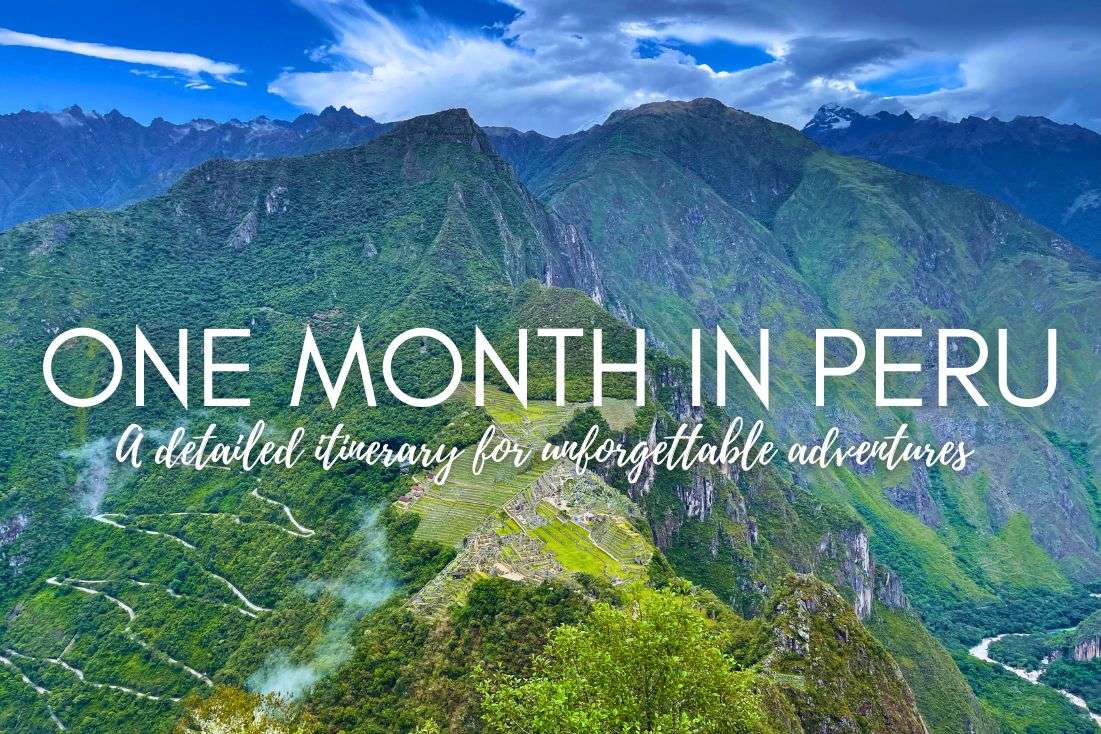
How to spend 1 month in Peru? Entire trip overview:
Peru itinerary map: What to see in Peru in 1 month
My top tips for one month in Peru:
Day 1: Arrival in Lima + getting to your hotel
Day 2: Lima: Historic center and Miraflores
Day 3: Chan Chan, UNESCO World Heritage Site
Day 5: Paracas and Paracas National Reserve, the coastal gems of Peru
Day 6: Islas Ballestas boat tour and water sports in Paracas
Day 7: Sandboarding in Huacachina and pisco tasting Ica
Day 8: Nazca Lines day trip (and lots of driving)
Day 9: Drive to Lima, then fly to Arequipa
Day 10: Arequipa, Peru’s “White City”
Day 11: Laguna de Salinas and whitewater rafting
Day 12: Hit the main viewpoints of Colca Canyon + see condors
Day 15: Inca sites in and around Cusco
Day 16: Day trip through Sacred Valley, the heart of the Inca Empire
Day 17: Travel to Aguas Calientes and first day at Machu Picchu
Day 18: Machu Picchu, part 2: Take a hike!
Day 20: Rainbow Mountain—a must-do Peru adventure!
Day 21: Travel to Puno and Lake Titicaca
Day 22: Lake Titicaca, the highest lake in the world
Day 23: Lima: Travel back to Lima
Day 24: Iquitos, the capital of the Peruvian Amazon
Day 25: Pacaya Samiria National Reserve
You’ve got ample time off and you’re going to Peru—awesome! Getting a full month in Peru is a fantastic idea considering how huge the country is and how packed with interesting places it is, including some of the most popular tourist attractions in Peru. Learn more about Peru.
I’ve got a day-by-day trip plan for you complete with main places of interest, travel times and distances and my insider tips about how to smash the most out of your Peru itinerary. In one month, you’ll be able to cover hotspots like Lima, Cusco, Sacred Valley and Machu Picchu (the Inca Empire’s crown jewels!), the Peruvian Amazon, and Lake Titicaca, while adding amazing underrated spots like Paracas and Arequipa.
Short on time? If you only have 2 weeks to travel, see my 2-week Peru itinerary.
Without further ado, behold, a 1-month Peru itinerary, curated to the last minute by me, based on my own adventures, for the best Peruvian adventure:
How to spend 1 month in Peru? Entire trip overview:
Day 1–2: Lima
Day 3: Chan Chan
Day 4: Trujillo
Day 5: Paracas National Reserve
Day 6: Islas Ballestas
Day 7: Huacachina and Ica
Day 8: Nazca Lines
Day 9–11: Arequipa and Laguna de Salinas
Day 12: Colca Canyon
Day 13–15: Cusco
Day 16: Sacred Valley
Day 17–18: Machu Picchu
Day 19: Humantay Lake
Day 20: Rainbow Mountain
Day 21–22: Lake Titicaca
Day 23: Lima
Day 24: Iquitos
Day 25—28: Amazon Jungle (Pacaya Samiria National Reserve)
Day 29: Lima
Day 30: Departure
Sometimes, all you need to do is take the first step... I've filtered out the best hotels in Peru for you
Save it for yourself to come back to later, or share with your friends on social media!
Peru itinerary map: What to see in Peru in 1 month
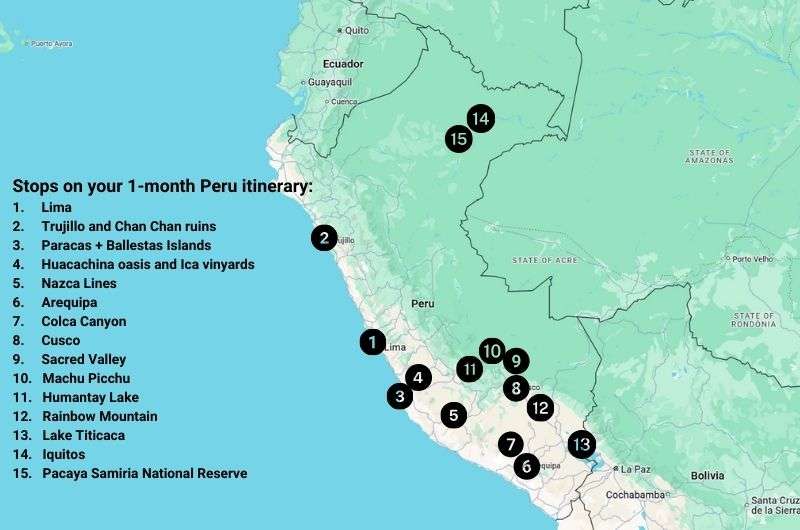
Here you can see this Peru itinerary on the map
My top tips for one month in Peru:
- Peru is huge. Flying between destinations is time-saving and cheap.
- Two weeks in Peru is not enough. If you can go for month, do it. Even then you won’t see everything.
- Don’t forget you need to book your Machu Picchu tickets months in advance.
- The international rental car companies in Peru are a joke. Rent a car at Alkila Rent a Car in Arequipa and Cusco, the only rental company that didn’t try to scam us.
- Stay in international hotel chains. Not something I usually stick to, but in Peru, everything else is low value. I got amazing deals at places like the Hilton Miraflores in Lima and the Hilton Garden Inn in Cusco.
Day 1: Arrival in Lima + getting to your hotel
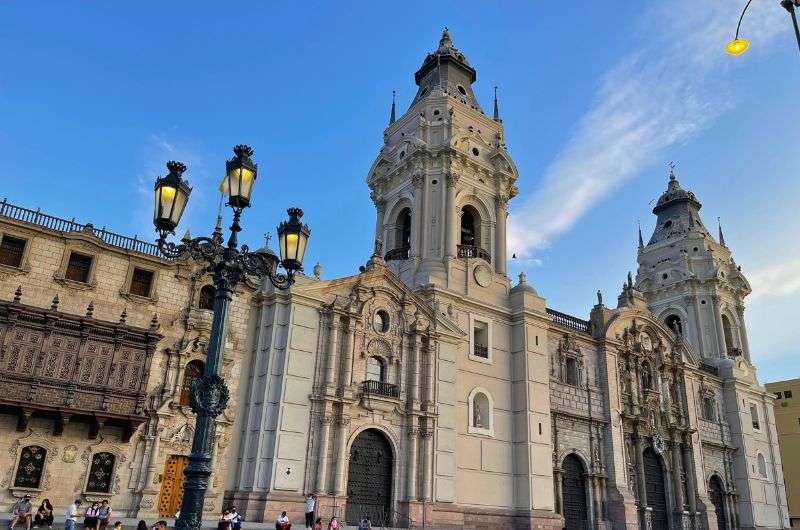
Lima—you don't want to be driving here but you should dock here at least once on your Peru visit
Ah, Lima, you terrible beast. It’s one of those places you have to either love or hate, and, since I attempted driving in Lima, I’m leaning on the hate side. Without the driving, I’d be hovering around neutral.
Once you leave Lima airport aka the most frustratingly slow airport I’ve ever met, you’ll be happy to find that the airport isn’t located out in no man’s land, and you’ll be doubting your decision to go to Lima in the first place in the comfort of your own hotel room in only about 15 minutes. The entire trip to Peru will be an adventure!
Tip: Don’t get a Peruvian SIM card at the airport. The prices are extremely high compared to what you get in town. Learn more Peru travel tips.
For travelers arriving at Lima airport on most international flights, getting a taxi or using Cabify is the easiest option. On the Cabify app on your phone and always choose the best class of car available, because anything less than luxury and you’ll be glad the car has doors, let alone seatbelts. It’ll cost about USD 18. Getting a regular taxi that is waiting at the airport will cost a little more, around USD 25.
Tip: If you’re flying into Lima early and my description of Lima doesn’t entice you, you can see the main bits of Lima on arrival day and get the heck out of there the very next morning.
Otherwise, leave day 1 as a travel day and see some of the (admittedly good) things to do in Lima the next day in a more relaxed manner. Stay within walking distance of Miraflores attractions.
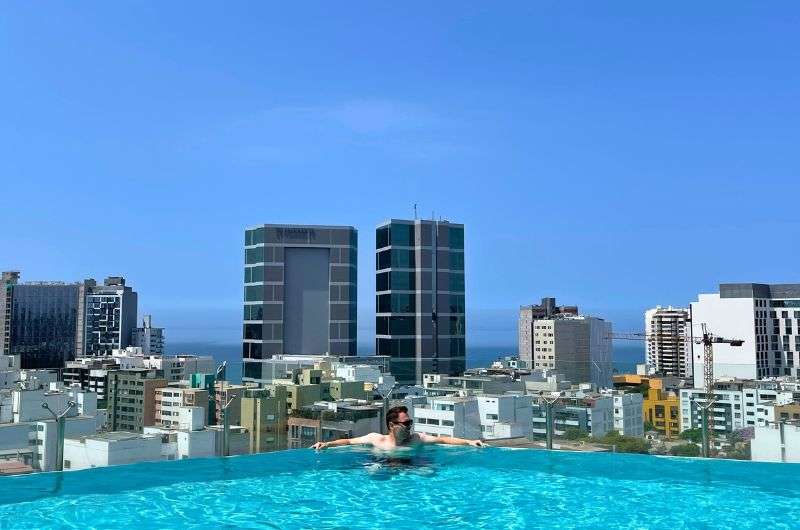
You can find some very nice hotels here (this is the Hilton Miraflores)
Hotels in Lima: Which neighborhood to stay in?
Get a hotel in the fancy Miraflores neighborhood so you can walk around at any time of day or night without feeling like someone is always lurking in the shadows watching you. This is the safest neighborhood in Lima, and the prettiest one, too.
I’m strongly recommending only staying in international hotel chains in Peru, because everything else is hit and miss. This isn’t my usual travel tip, but in Peru, I felt like a Hilton Hotel representative.
Why? You know what to expect, you don’t have to worry about the standard and staff always speak English.
My favorite hotel in Lima: The Hilton Lima Miraflores has some fantastic rooftop pools that’ll fix your first impressions of Lima faster than you can say cocktail. The breakfast is wonderful, the shower was probably the best I had in Peru and as an extra bonus, the hotel is QUIET. You can’t hear the horns of the crazy drivers. It’s like your own little sanctuary.
Day 2: Lima: Historic center and Miraflores
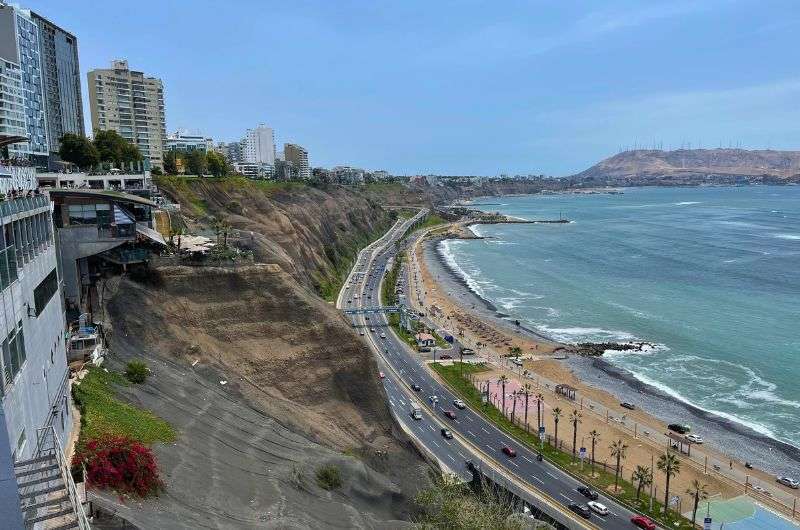
Let's explore the best of Lima
Main sites visited on day 2: Lima historic center, Plaza de Armas, Lima Cathedral, Basilica and Convent of San Francisco, Larco Museum, Miraflores
Hotel recommendation: Hilton Lima Miraflores
Morning in Lima: Plaza de Armas and Lima’s UNESCO Heritage Site
For sightseeing in Lima, you’ll need to take a taxi to the historic district. A taxi between districts won’t cost more than USD 3–4.
You’ll want to wander around Lima’s most popular tourist attractions, like the Plaza de Armas. There you’ll see Lima’s typical yellow buildings with their dark wooden balconies, otherwise known as spy boxes for the rich. Wander around the historic district and tour the Basilica and Convent of San Francisco. It’s a whole religious precinct right by the Plaza de Armas.
Tickets for the guided tours are on a first come, first served basis and come PEN 15. Tours are available in English and Spanish.
Tuck into one of the many restaurants for lunch and relax for a few hours. Some of my favorite restaurants in Peru are in Lima. If you want a good coffee, choose something hipster-looking, otherwise it’ll taste like dirty water. Learn more about what’s good to eat and drink (and what isn’t!).
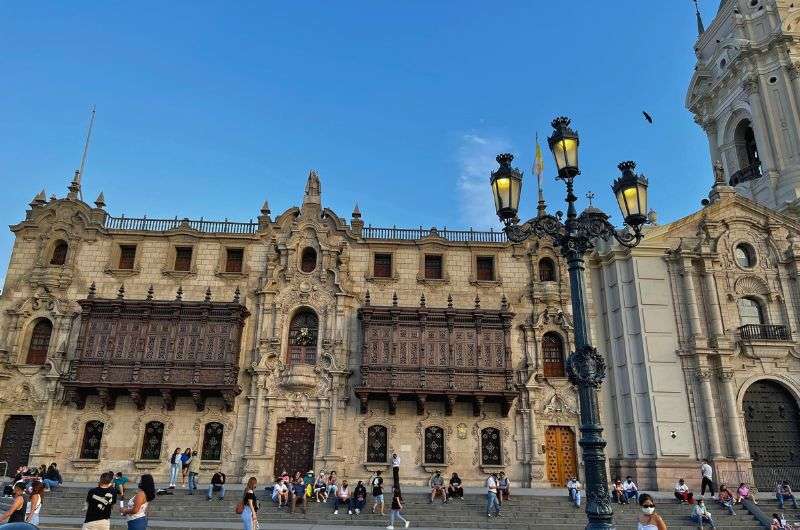
Take time to look at the famous wooden balconies on the buildings on Plaza de Armas
Afternoon in Lima: Larco Museum and Miraflores
The highlight of Lima is the Larco Museum. It’s in a gorgeous mansion, it’s well organized, the descriptions are clear and informative, and you learn tons about the history of ancient Peruvian civilizations. A must at the beginning of any trip to Peru.
Take a taxi there from Plaza de Armas and allocate at least 2 hours for the tour unless you love these kinds of museums and want to read each and every sign, in which case set aside 3. Tickets cost PEN 35.
Plan on spending the late afternoon and evening in the upscale Miraflores neighborhood. It sits to the south of central Lima atop the cliffs over the ocean with tons of restaurants, shopping, top hotels and great views from the boardwalk/sidewalk atop the cliffs. The sunsets here are spectacular.
Day 3: Chan Chan, UNESCO World Heritage Site
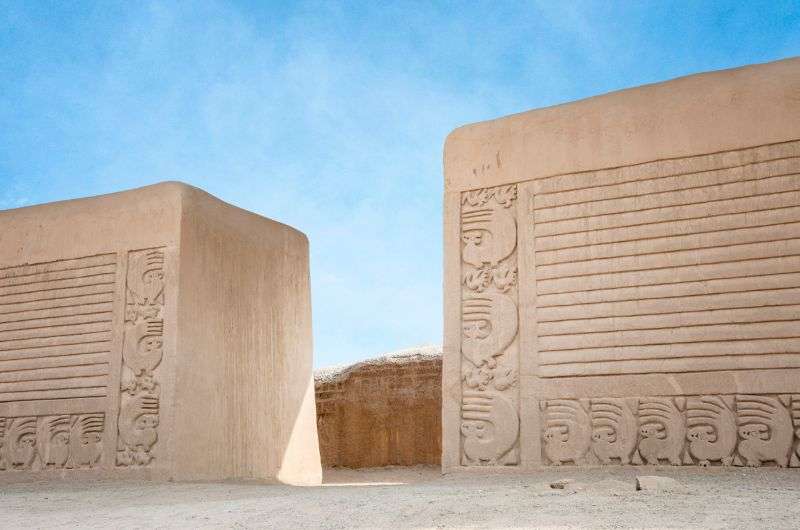
The Chan Chan ruins surprised me with how much detail is preserved
Main sites visited on day 3: Travel from Lima to Truijillo, Chan Chan ruins
Hotel recommendation: Costa del Sol Wyndham
Most of the main tourist spots are in southern Peru, but we’ll start this Peru itinerary by heading north for a couple of days first
Morning: Flight from Lima to Truijillo
Hop on a 1 h 15 m flight from Lima to Trujillo (it costs about USD 80). Trujillo is a big city with about 800,000 people. The main attraction here are the nearby Chan Chan ruins, so you’ll head straight there today. Taxi to Chan Chan will cost PEN 15.
Afternoon: Exploring the capital of Chimu Empire
Chan Chan was the capital city of the Chimu Empire roughly from 900–1470. In its time, it was the largest city in the Americas. Chan Chan is located a few kilometers west of Trujillo city on the coast of Peru 480 km (300 miles) north of Lima. It covers an area of 20 km2, making it the largest adobe city in the Americas and second in the world.
The central city of Chan Chan was split into ten walled palaces, each containing temples, residences, ceremonial halls etc. You can see the reliefs and carved decorations on the walls.
Don’t worry though, only a relatively small part of the ruins are open to the public, you don’t need to cover 20 km2. You’ll probably spend 2 hours exploring the area, preferably with a guide (PEN 50). Stop by the museum first and get your PEN 10 tickets there. Beware the site is closed on Mondays.
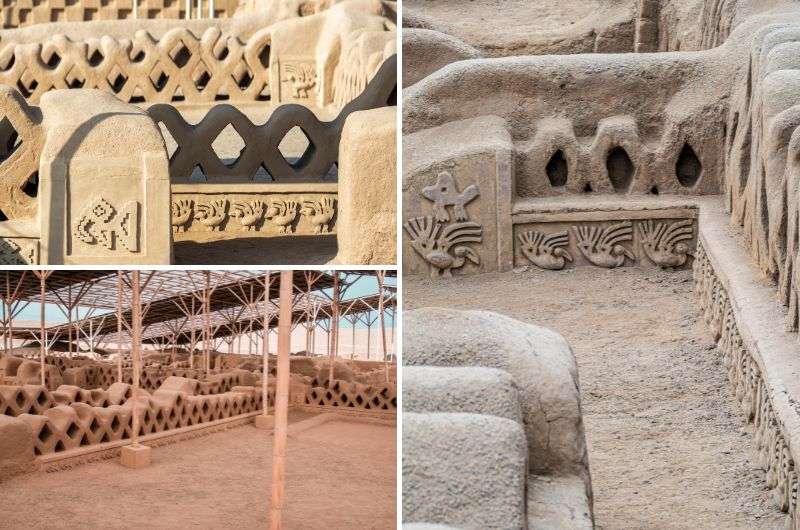
The Chan Chan ruins have a rich history
After Chan Chan, head back to Trujillo and stop by Huaca Esmerelda and Huaca Arco Iris, two temples that are included on your Chan Chan ticket. They are small sites, but hey, you’ve already paid for them, so you might as well take a look.

Day 4: Exploring Trujillo

Trujillo
Main sites visited on day 4: Temple of the Sun, Temples of the Moon, Plaza de Armas, Carmen Church and Monastery
Restaurant tip: Restaurant Squalos
Hotel recommendation: Costa del Sol Wyndham
Morning: Visiting ancient temples
Get a taxi (PEN 8) over to the Temple of the Sun (Huaca del Sol) and the Temple of the Moon (Huaca de la Luna) today. They aren’t large sites, and at the time of writing, the Temple of the Sun isn’t available to visit, but they are worth a stop. Some people even like the area more than Chan Chan.
The Temples of the Sun and the Moon, from Moche period, are 700 years older than Chan Chan.
Afternoon: Wandering around the city center
Take time to get a nice lunch in the city center and stroll around the Plaza de Armas is one of the most colorful in Peru, with not just the typical yellow buildings, but also blue and red as well.
The La Libertad statue in the middle was made in France out of marble and copper. The Trujillo Cathedral Basilica is very yellow inside and out, while the nearby Carmen Church and Monastery also deserves a visit, at least as a passer-by.
Day 5: Paracas and Paracas National Reserve, the coastal gems of Peru
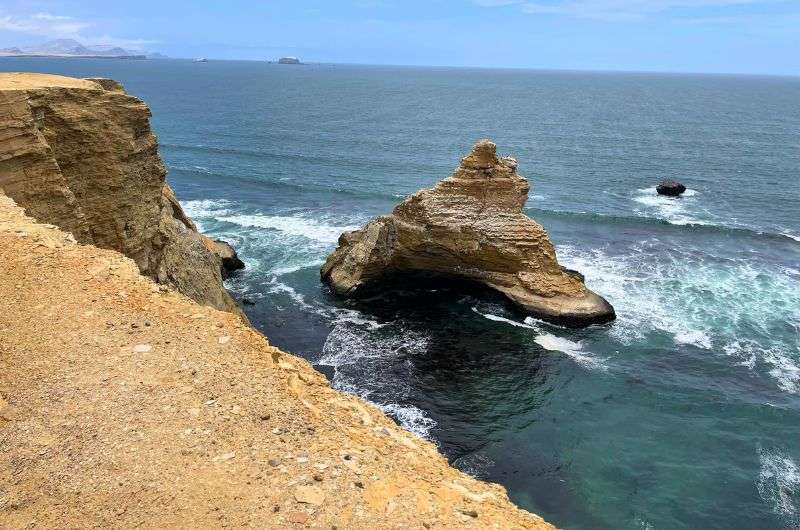
Paracas will be one of your favorite stops on your Peru visit—guaranteed!
Main sites visited on day 5: Paracas National Reserve
Restaurant tip: Cevichería La Tia Fela
Hotel recommendation: The Legend Resort by Hyatt
The time has come to go down south! Welcome to Paracas, a small beach town on Peru’s southern coast.
Morning: Traveling to Paracas
You’ll want to get the early morning flight from Trujillo to Lima. Remember they are only about an hour long and cost less than USD 100.
In Lima, rent a car and off you go to a town called Paracas, home of the Paracas National Reserve. It’s also the starting point of the boat trips to the Islas Ballestas, which is in plans for tomorrow.
Most rental places I tried in Peru sucked even though they were part of the biggest brands of rental companies. Instead, read reviews online and don’t be afraid to rent through a local agency with high ratings.
Renting a car in Peru isn’t cheap. The actual rental price of USD 50–70 per day for an SUV or similar vehicle is ok. But add on collision insurance and you’ll double the price.
From Lima, Paracas town is a 3-hour, 250 km (150 mile) drive on the Pan-American Highway. The trip is long but the road is good and hey, you drove on a small part of the world’s longest road!
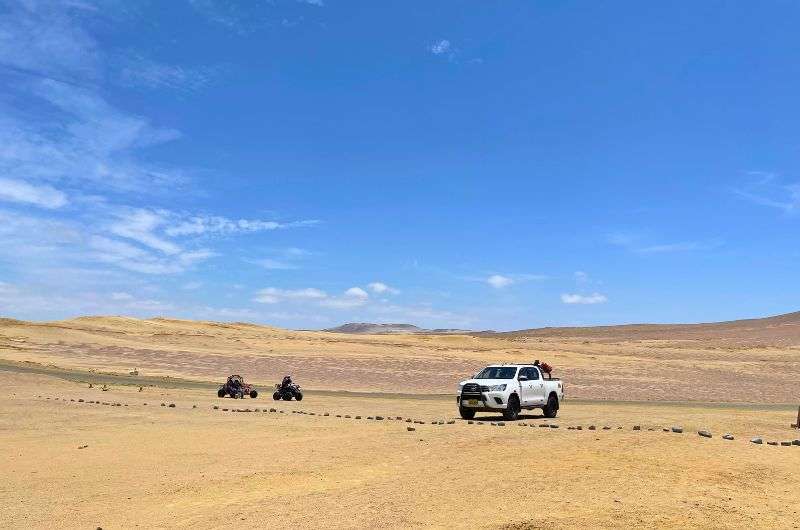
You can't go to Paracas without a good SUV
Afternoon: Driving through Paracas National Reserve
You’ll spend most of your afternoon in the Paracas National Reserve. The desert here is vast and beautiful, and, coupled with the blue and turquoise shades of the ocean, is truly a memorable sight.
And guess what?! More time in the car! You’ll need 4 hours to drive the 23 km (14 miles) route in the national reserve, including stops to take in the views and explore the breathtaking desert landscapes, including the striking sand dunes.
You buy your tickets and get your map at the main entrance on the road just south of Paracas town. The road is easy to navigate.
Before you get to the last stop on the map you’ll find an area with a bunch of ocean-side mom and pop restaurants. Our favorite was Cevichería La Tia Fela. The chairs were plastic but the fish were super fresh!
Read my article about the top things to do in Paracas for details about the individual stops.
Day 6: Islas Ballestas boat tour and water sports in Paracas
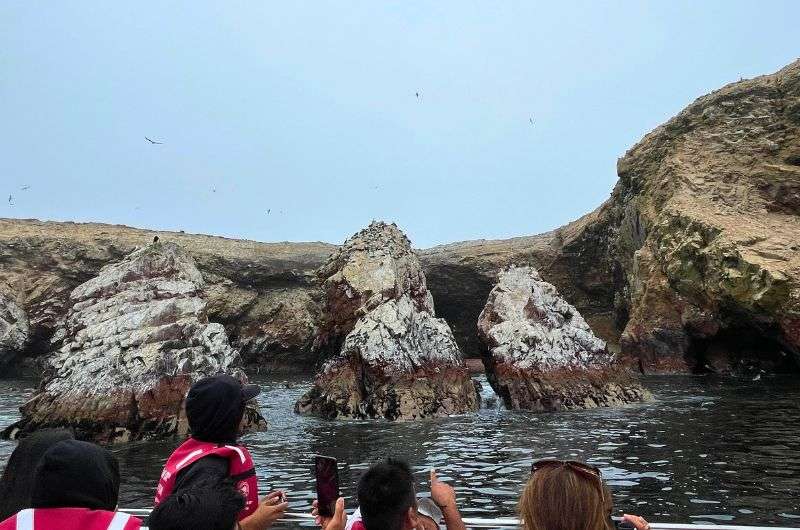
Slightly overrated Peruvian attraction, Islas Ballestas. But they are worth the day trip!
Main sites visited on day 6: Ballestas Islands, fun on the water in Paracas
Hotel recommendation: The Legend Resort by Hyatt
Morning: Taking a boat tour out to Islas Ballestas
The Islas Ballestas, or Ballestas Islands, are a popular stop on a lot of people’s Peru itinerary. It’s a small group of rock formations jutting out from the sea. They’re famous for the thousands of birds that congregate on the rocks and make them nice and poopy and ready for guano mining. You’ll also get to check out tons of seals, sea lions, and penguins.
To get to the Islas Ballestas, you’ll need to go on an organized boat trip by one of the many tour companies in town. And since the sea is much calmer in the mornings than in the afternoons, that’s the time I recommend going. That said, early morning often brings fog, but it usually clears up by the time to boats get to the islands.
Group tours go for about 25 USD per person and may or may not include the PEN 13 entrance fee to the national reserve. If the price doesn’t include the fee, you will pay it at the pier. Hotel pick-up and drop-off can also be extra.
Tours take 2 hours start to finish.
To be honest, I thought this tour was just ok. Get details about it in my Islas Ballestas travel guide.
Afternoon: Kayak, SUP, or catamaran rental?
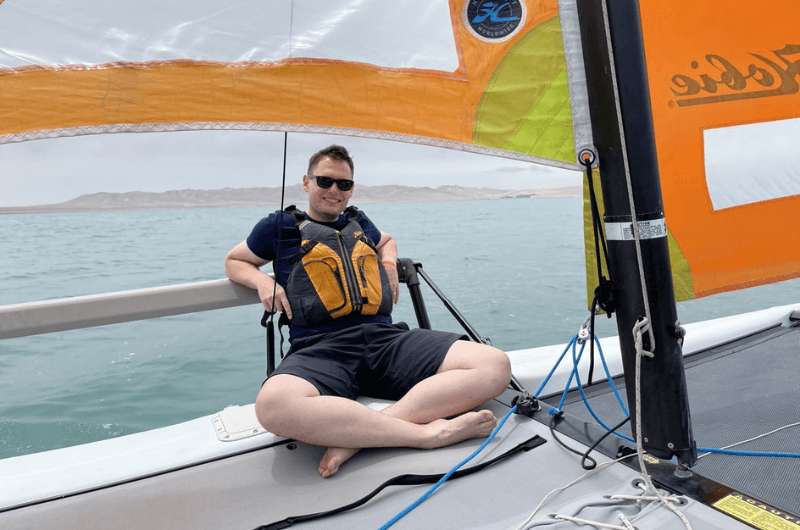
Somebody get this man a cocktail
After your boat trip, you’ll have the afternoon to either spend time at your hotel, try your hand at paddleboarding or similar water-based sport. There are massive jellyfish in the water everywhere in Paracas, so if you’re stability isn’t too hot, opt for a kayak.
Better yet, rent a catamaran and sip your cocktail there, jellyfish-free and with no effort whatsoever.
Alternative: If you want to head out for more exploring, consider seeing the ruins at Tambo Colorado, about an hour from Paracas.
Day 7: Sandboarding in Huacachina and pisco tasting Ica
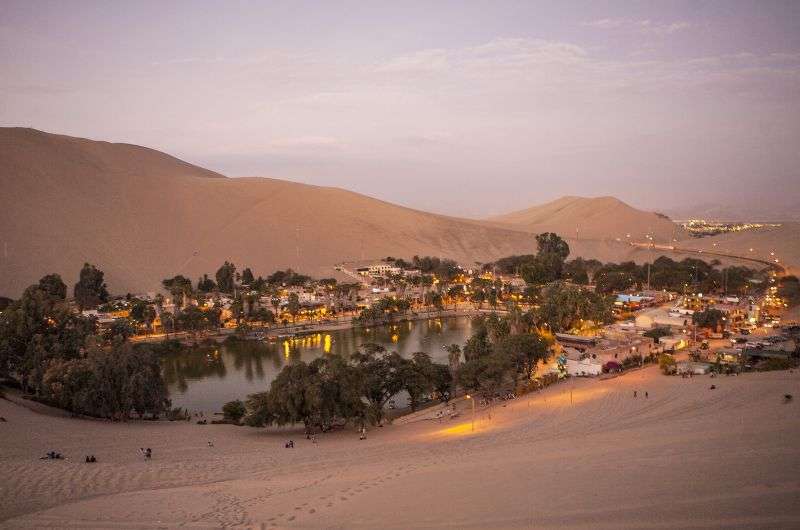
Huacachina desert oasis
Main sites visited on day 7: Ballestas Islands, fun on the water in Paracas
Restaurant tip: Los Horcones Restaurant
Hotel recommendation: The Legend Resort by Hyatt or stay in Ica for a night instead
Morning: Have fun in Huacachina desert oasis
Drive 1 hour to the Huacachina desert oasis, which is about 75 km (46 miles) east of Paracas. Seeing a seemingly random body of water in the middle of the desert is cool to see, but the main draw here is the sand.
This desert oasis is surrounded by massive sand dunes perfect for sandboarding, sandskiing, and sand buggy rides. You can choose a tour that’ll get you a guide for whichever activity you choose. Those are usually 3 hours long and cost anywhere between USD 20 and USD 60. I recommend Dito Sand Xsports, founded by four-time sandboarding world champion Dito Victor Chavez.
There’s a small town that has popped up around the oasis with several eating options.
Afternoon: Take a distillery tour in Ica
Just a hop and a skip away from Huacachina—if you can call 16 km (10 miles) that—lies the city of Ica. And on its northern side are the vineyards you’ll be visiting this afternoon.
Visit to the oldest distillery in South America—established in 1684—, La Caravedo (look for Hacienda Destilería La Caravedo in Google Maps). They give you a free tour of the facilities. It takes 1.5 hours and is only in Spanish, but you get to try free pisco samples at the end. It’s the next level of wine: distilled wine=grape brandy!

Nice yellow mansion La Caraveda
Beware that the road you will be taking looks like you’re driving to someone’s granny’s house, but trust your GPS and persevere. You’ll arrive at a stunning yellow mansion, and you’ll know you’re in the right spot.
Stay for dinner and enjoy the huge portions at the on-site Los Horcones Restaurant
.
Day 8: Nazca Lines day trip (and lots of driving)
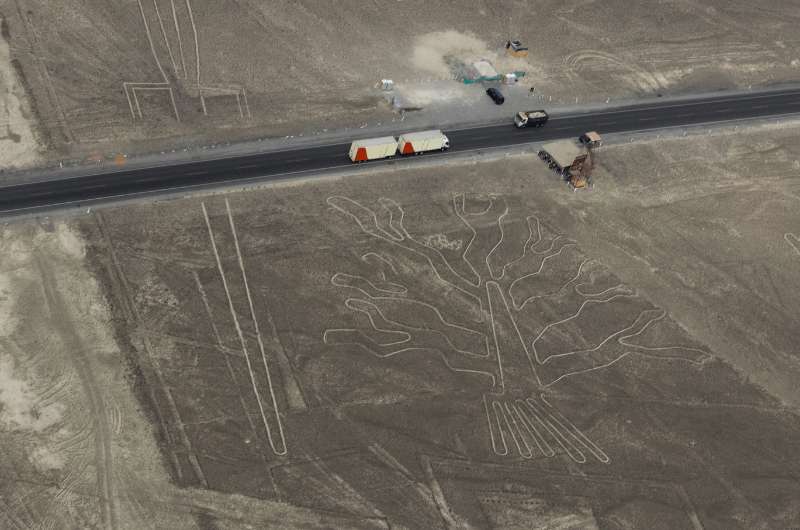
Nazca Lines. Sure, put a road through it, it’s not like it’s special or anything.
Main sites visited on day 8: Maria Reiche Museum, Nazca viewing tower, plane tour of Nazca Lines
Hotel recommendation: The Legend Resort by Hyatt
Road trip! That’s just a fun way of saying you’ll be driving a lot today. Spoiler alert: You’ll be driving a lot tomorrow, too.
You’ve probably heard of them: huge, strange shapes carved into the ground in the Nazca Desert in Peru. Geoglyphs that look like everything from a hummingbird to an astronaut that are shrouded in mystery.
Now you, too, can go take a guess as to how and why the Nazca people made these designs.

Morning: Driving to the Nazca Desert
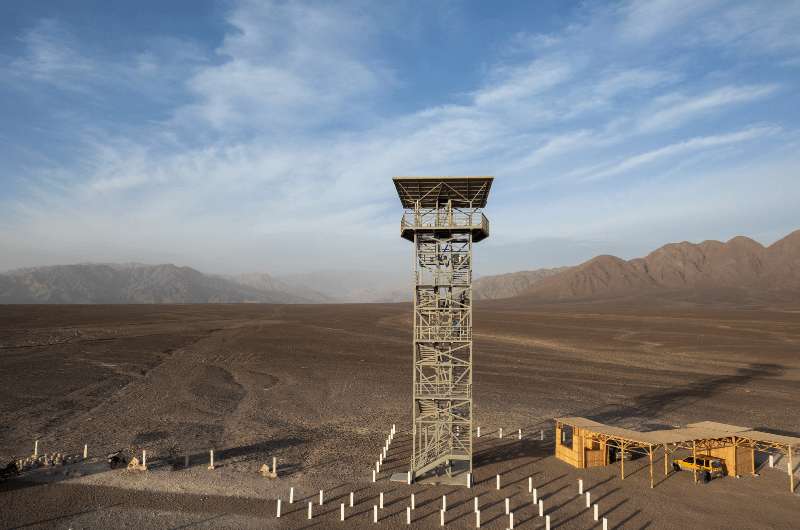
Climb up this tower if you want to see for yourselves that you simply cannot see the Nazca Lines unless you’re in the air.
The Nazca Lines are located 115 km (70 miles) south of Ica.
You first stop after the 2-hour drive will be at the Maria Reiche Museum. The museum used to be the home of the “Lady of the Lines”, as German-born Peruvian Maria Reiche was known for her life-long efforts to study and protect the Nazca Lines. You’ll be done with the small museum within 30 minutes.
Continue a few more minutes on the same road and you’ll see the Nazca Lines viewing tower. It costs only PEN 2 to climb to the top of the tower and find out you can’t see shit of the actual shapes of the geoglyphs, but take it as your first taste of the weird lines.
The road you drove here on actually cuts through some of the Nazca Lines. You aren’t allowed to walk into them, but you can get a very clear glimpse over the guardrails.
Afternoon: Flight over the Nazca Lines
By now you are starving, so continue another 20 minutes to Nazca town and eat something. None of the restaurants are anything to write home about, so read Google reviews and just pick something. You might find a gem!
The main event of the day is a flight over the Nazca Lines. The shapes are so big that you have no chance to see them in their entirety off the ground. Enter plane!
Nazca Lines tours depart from the Maria Reiche Neuman Airport and cost USD 100 per person for a 30-minute, nausea-inducing flight. The pilots will be tilting the little planes to either side so that everyone can get a good view of the ground.
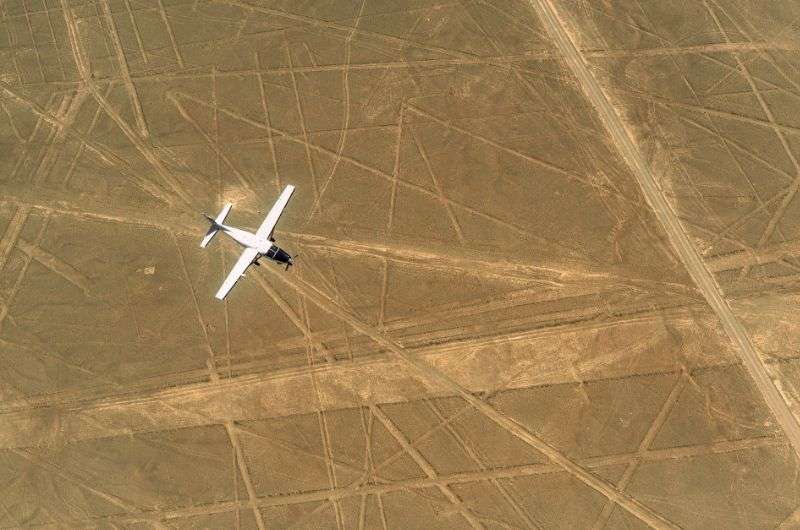
From the plane you will see Nazca Lines at its best
Read our full Nazca Lines article for details on all the various ways to see the Nazca Lines.
After you set foot on solid earth again, you can continue making your stomach upset by getting back in your car and heading back home.
Where home is tonight depends on whether you decide to return for another night of pisco tasting in Ica, or prefer to get back to Paracas ahead of the long drive to Lima tomorrow.
Day 9: Drive to Lima, then fly to Arequipa
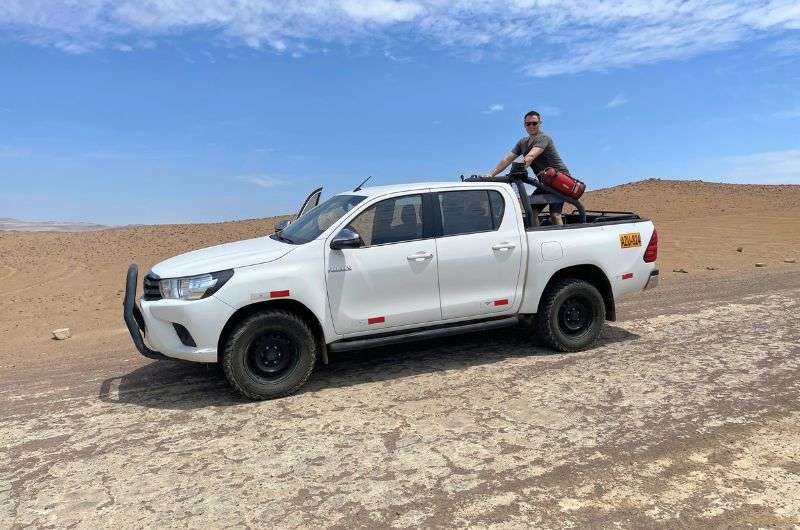
Even though this car was comfortable, you do not want to spend 13 hours in it
Main sites visited on day 9: travel day
Hotel recommendation: CIRQA - Relais & Châteaux
Today you will hate me. But it’s not my fault that Peru is so damn huge!
You’ll be driving back up to Lima and then flying down to Arequipa. It seems like backtracking but it’s either that or driving for 13 hours covering 780 km (480 miles) from Paracas to Arequipa. A hard pass on that from me.
First, drive 250 km (150 miles) from Paracas to Lima, drop off your rental car, and then reach for the sky!
There are over 60 flights from Lima to Arequipa a day. They take 1.5 hours and plane tickets cost USD 50.
Get a rental car at the airport. Use Alkila Rent a Car and be prepared to pay upwards of USD 100 per day.
Day 10: Arequipa, Peru’s “White City”
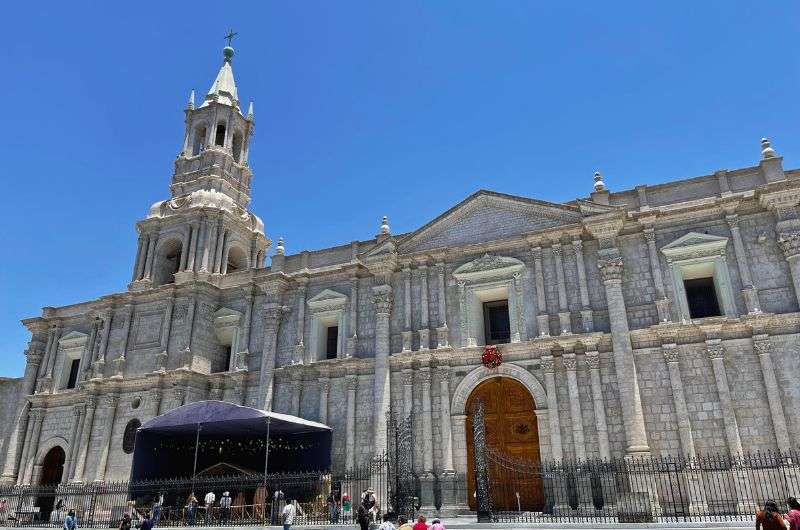
The Arequipa Cathedral
Main sites visited on day 10: Plaza de Armas, Arequipa Cathedral, Santa Catalina Monastery, Mundo Alpaca museum
Restaurant tips: 13 Monjas, Pasta Canteen
Hotel recommendation: CIRQA - Relais & Châteaux
It’s time to slow down for a bit. With no driving and no big adventures today, you’ll have enough time to take in the whiteness of the White City of Arequipa. Everything here is built from the white volcanic rock called sillar, giving Arequipa a unique, bright appearance.
Beware of the altitude
You’ll also be starting your acclimatization process. Arequipa sits at 2,300 m (7,600 ft) above sea level, which is nothing compared to Cusco’s 3,400 m (11,000 ft). This is why I recommend going to Arequipa first and to Cusco second, getting used to the thinner air bit by bit, or else facing the wrath of altitude sickness. The side trips out of Arequipa will take you to very high altitudes, too, so having a lower ground to retreat back to is a plus.
You can walk everywhere in Arequipa’s city center. I didn’t exactly feel safe in the outskirts, so maybe don’t go there, or, if you must, take a taxi. Also, driving in Arequipa is almost as crazy as in Lima.
Morning: Walking around the city center
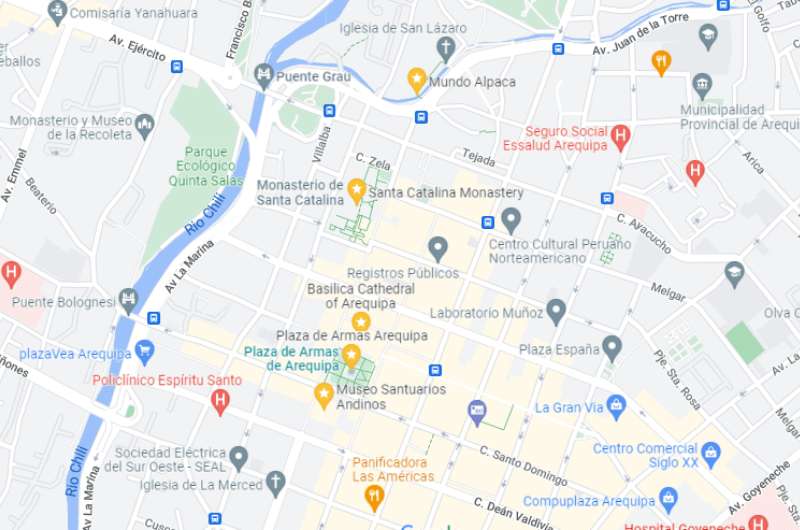
Here are highlighted the main places of interest in Arequipa
After plenty of beauty sleep and a hearty breakfast, take a walk around the Plaza de Armas. The main square is the nicest I’ve seen in all of Latin America. It’s full of cafes and shops. El Misti Volcano looms in the background just asking for tons of photos.
The massive, white Basilica Cathedral of Arequipa is an obvious standout in the city center. It’s right on the Plaza de Armas. To visit the cathedral, you’ll need to buy your ticket for PEN 10, which includes an hour-long guided tour (you can’t visit on your own). Be sure to dress appropriately—cover knees and shoulders.
The views from the cathedral’s rooftop are pretty spectacular!
Afternoon: Santa Catalina Monastery and an alpaca museum
Spend at least a couple of hours walking through the neighborhoods of Santa Catalina Monastery that used to be like the Monaco of monasteries. Easy to visit on your own, though guides are available. Tickets cost PEN 40.
Continuing up a bit further north is the Mundo Alpaca, a museum where you’ll learn the difference between alpacas and llamas and learn all about the textile industry that these animals have helped create.
Entrance is free but you’ll be sure to drop a dollar at the museum shop. Sweaters for everyone!
Day 11: Laguna de Salinas and whitewater rafting
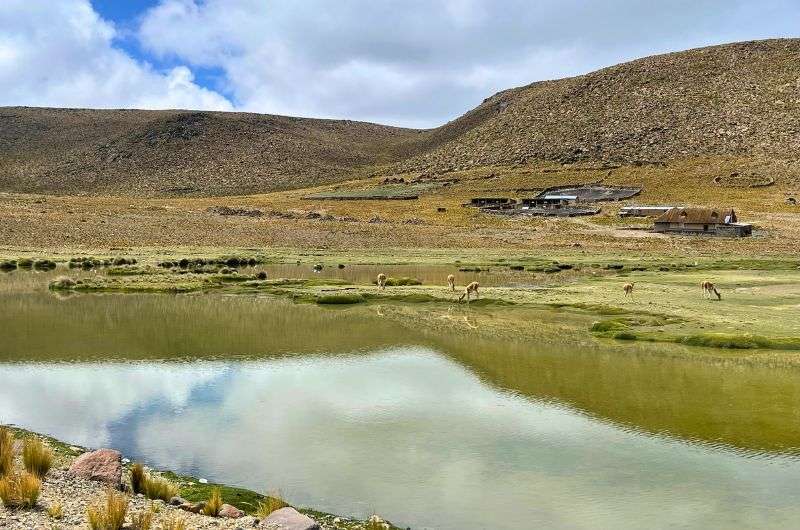
Laguna de Salinas
Main sites visited on day 11: Salinas Lagoon, rafting on Rio Chile, Ruta del Sillar
Restaurant tips: 13 Monjas, Pasta Canteen
Hotel recommendation: CIRQA - Relais & Châteaux
No more of this lazy business, today is the day you see some salty flamingos!
Morning: Head out to Salinas Lagoon
You’ll be visiting Laguna de Salinas, the most beautiful nature reserve I’ve seen in a long time. Like ever. The mix of the wetlands with tons of llamas, alpacas and flamingos and the snow-covered peaks of the mountains above, makes for a landscape like no other.
The drive to Laguna de Salinas is 60 km (38 miles) from Arequipa and takes 2 hours one way. You’ll be climbing up to Laguna de Salinas‘ 4,300 m (14,000 ft), continuing your acclimatization efforts.
Spend an hour or two taking way too many photos, trying to position yourself for that perfect shot with El Misti in the center and a flamingo cuddling a llama mirrored in the lagoon.
Take note that during the dry months of May to November, there is no lagoon to speak of, instead leaving behind a salty crust on the ground. With no water, there are also much fewer animals, so keep that in mind if you’re visiting in the wrong part of the year.
Afternoon: Brave the white waters of Chile River
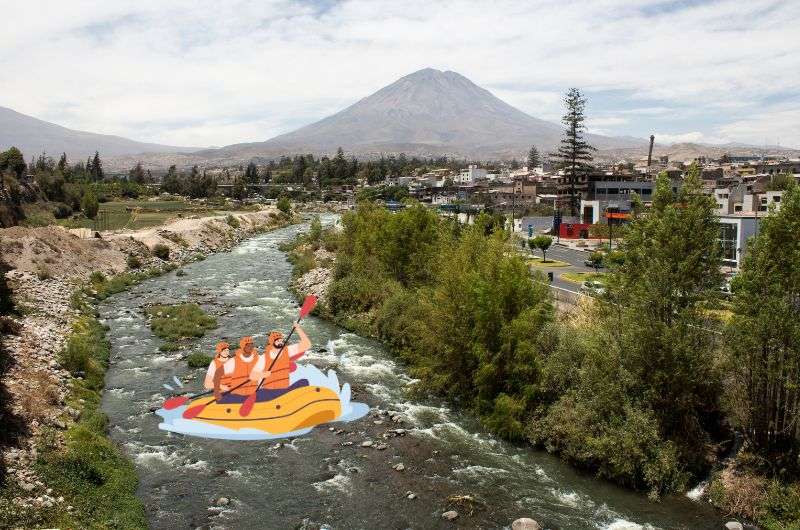
You have to try rafting on the Rio Chile
If you are in Peru during the dry months and don’t feel like getting car sick just to see some salt on the ground, opt for some whitewater rafting on Rio Chile instead. Actually, you could do both in one day if you’re that kind of over-active type!
I absolutely loved this rafting experience. The rapids were real, not letting us rest the whole 1.5 hours we were on the water.
The rafting part of the trip starts just 20 minutes outside of Arequipa’s city center and takes a total of 3 hours including transportation, wetsuiting up and instructions. Most companies have 2–3 departures a day. Prices start at USD 25.
Got time for more?
If you need something to fill in the last hours of the day, take a look at Ruta del Sillar.
It’s a sillar quarry where you can go and see a variety of statues made of the volcanic rock. A 30-minute drive awaits you if you head over from Arequipa’s center.
Tickets are just PEN 5 and you will probably only spend 30–60 minutes at Ruta del Sillar.
Day 12: Hit the main viewpoints of Colca Canyon + see condors
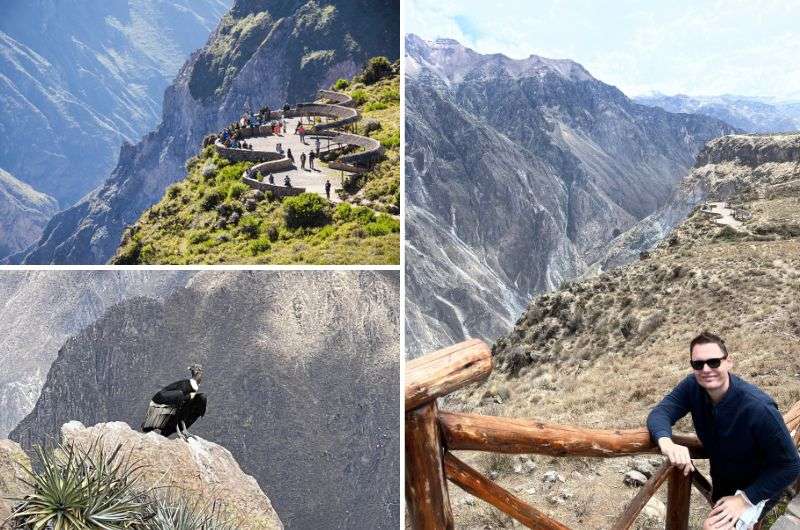
Colca Canyon
Main sites visited on day 12: Mirador Cruz del Cóndor
Hotel recommendation: CIRQA - Relais & Châteaux
Today you’ll take on Colca Canyon, the second deepest Canyon in the world that cuts 3,400 m deep into the mountains.
In all honesty, today’s driving is an undertaking to say the least—4 hours one way (with some short breaks). But you’ve come this far, don’t give up! It is 120 km (75 miles) from Arequipa.
Colca Canyon is the biggest reason people even come to Arequipa, so you gotta go. Plus, there are condors! Otherwise known as the huge, ugly-headed birds that gave name to the most famous lookout point, Mirador Cruz del Cóndor. Many treks start from this point. You can continue to Cabanaconde for more viewpoints.
You can spend as little or as much time as you want at Colca Canyon. I was happy with just the viewpoints, but by all means, take a hike.
Colca Canyon is pretty high up, with the Cruz del Condor viewpoint at an altitude of 3,700 m (12,000 ft). You might want to stock up on some coca just in case you experience mountain sickness.
Colca Canyon will take up all day.

Day 13: Cusco historic center
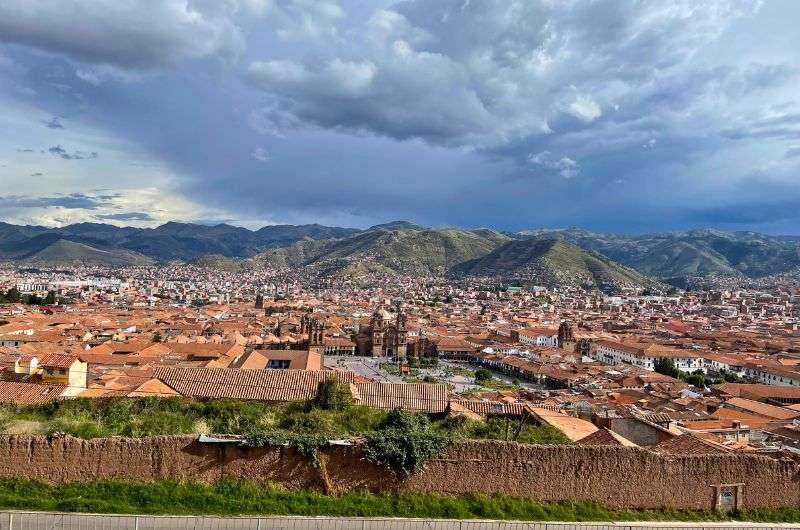
Cusco
Main sites visited on day 13: Plaza de Armas, Inca Museum, Cusco Cathedral, Inca Rock Streets, San Cristobal viewpoint
Restaurant tips: Uchu Peruvian Steakhouse, Garden Grille (at the Hilton Garden Inn)
Hotel recommendation: Hilton Garden Inn
Flights from Arequipa to Cusco take an hour and cost around USD 100.
Rent a car. You can again do that at Alkila Rent a Car. Alternatively, a taxi from Cusco airport to the city center is USD 25. You can use the Cabify app in Cusco as well.
Cusco is one of the very few cities in the Americas that I think warrant a two-day stay. In this case it’s great because you might be feeling a little blah because of the altitude, so getting two days of “just” sightseeing in town will be just what your body needs to get back up to speed again.
No matter how long you can stay in Cusco, it's the highlight of any Peru itinerary. And don’t just book it to Machu Picchu, either! Cusco and Sacred Valley are must-sees.
A note on altitude sickness in Cusco
Once you disembark your plane in Cusco, you’ll be breathing heavier since you’re now in 3,400 m (11,000 ft).
If you come to Cusco directly from Lima, you’re almost certainly getting altitude sickness. If you took my advice and spent time in and around Arequipa first, you might get lucky and get altitude sickness a few days later once you head higher into the mountains.
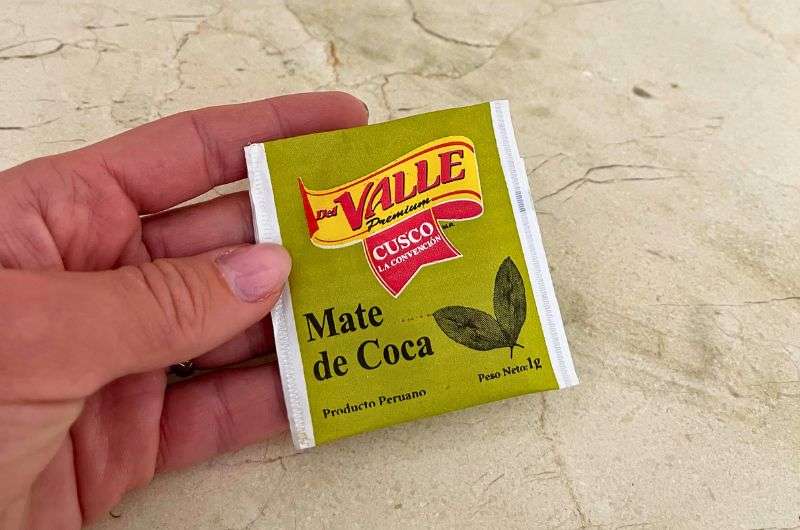
Always keep Mate de Coca handy
Morning in Cusco: Around Plaza de Armas
First stop: the Inca Museum Learn about everything you’re going to be seeing in Sacred Valley during the next few days. The Incas were a fascinating people and getting to know as much as you can about them will elevate your experiences from the ruins you’ll be visiting.
Definitely opt for a guide since the museum isn’t really that great when it comes to signs in English. Our guide was fantastic and really made our visit worthwhile.
Expect to spend at least 1.5 hours at the Inca Museum. Tickets cost PEN 10.
The Inca Museum is right by the Plaza de Armas, so spend some time there and at the massive Cusco Cathedral. It has three parts and includes a museum with hundreds of artifacts, sculptures and paintings, the most famous of which is Marcos Zapata’s Last Supper where guinea pig is served as the main course.
You’ll need an hour to properly look around. Tickets cost PEN 30.
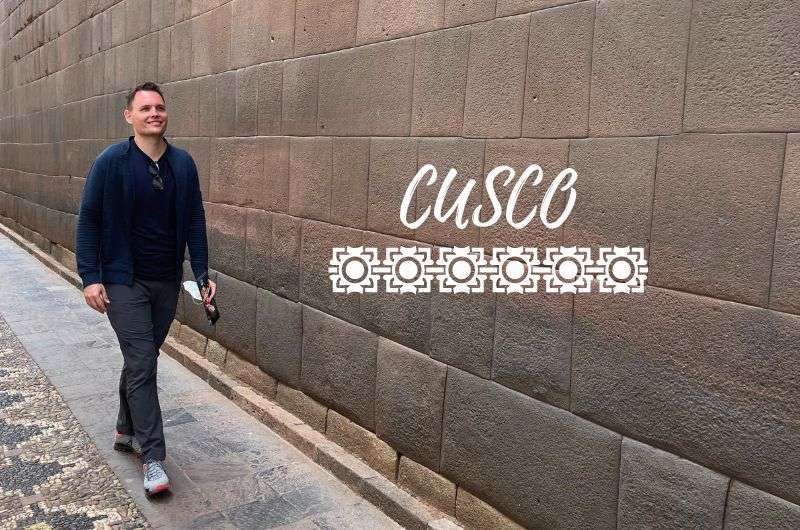
Walking the streets of Cusco
Afternoon: Marvel at the best city viewpoint
Walk through the side streets of Old Town. Don’t forget about Calle Hatunrumiyoc and Calle Inca Roca to check out the walls made of the Incas’ precisely cut stones. You really don’t need to do much, just walk and enjoy.
Then climb up to the viewpoint at San Cristobal Church and ooh and aah over what is in front of you: the Plaza de Armas surrounded by the red rooftops of Cusco, bordered by the magnificent Andes in the background. Priceless.
It’s a short (15 minutes max) but steep walk from Plaza de Armas. Your ticket from Cusco Cathedral automatically gets you into the San Cristobal Church if you’re interested. It’s nothing that special, the views of Cusco are the real attraction here.
Hotel in Cusco
Another day, another Hilton? The Hilton Garden Inn Cusco had super comfortable beds, wonderful staff and though it’s located a 10-minute walk to the Plaza de Armas, the bonus is that it is quiet. The spa is so good, they even have a special acclimatization massage. Add one of our favorite restaurants in all of Peru, the Garden Grille, and you have one of the best hotels in Cusco.
Day 14: Cusco city center
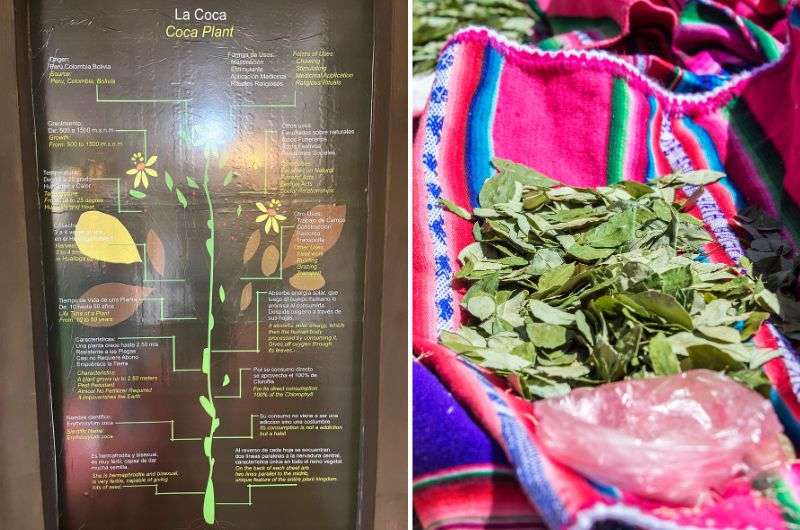
In Cusco you can learn all about the coca plant at the Coca Museum
Main sites visited on day 14: Museum of Pre-Columbian Art, Coca Museum, Qorikancha,
Restaurant tips: Organika, Garden Grille Restaurant
Hotel recommendation: Hilton Garden Inn
Today you get to see more of Cusco, learn more about Incas, and visit another very Peru-specific museum.
Morning in Cusco: Hit up some museums
First, head over to the Museum of Pre-Columbian Art of Peru right by the Plaza de Armas. It’s part of the Museo Larco group (the Museo Larco that knocked our socks off in Lima), meaning it’s very modern and up to European museum standards.
This museum presents the art and cultures of central Peru from the Mochica civilization to the Incas. You’ll need about an hour to go through the ten rooms of the museum. Tickets cost PEN 20.
You can also learn about another staple of the region: coca. Just remember not to buy everyone at home souvenirs from the Coca Museum, it’s illegal to take that stuff out of the country! It’s fascinating to learn about the plant that might just save you from altitude sickness on more than one occasion while you’re traveling in Peru, and the Sacred Valley and Cusco especially.
Free admission.
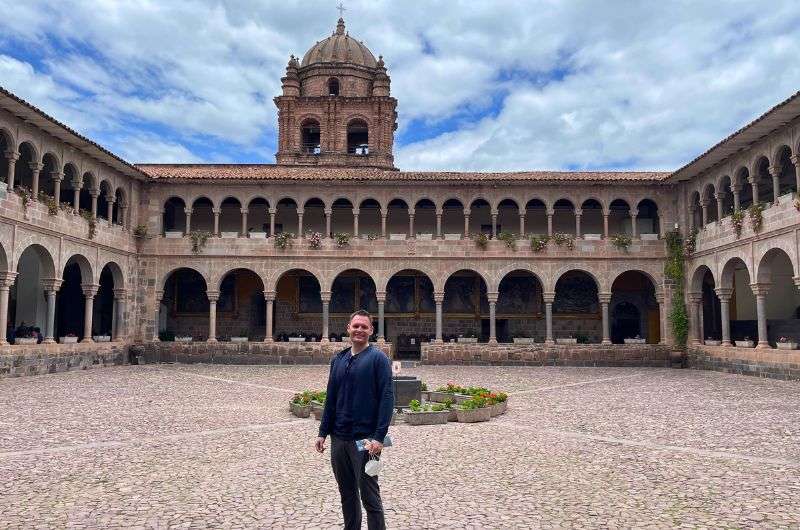
Museum of Pre-Columbian Art
Afternoon in Cusco: Qorikancha
After lunch, head to Qoricancha. It was the most important temple in Cusco during the Inca Empire. Though once the Spaniards took over, they took it apart and built a church on the leftover base, which is what you’ll see there now. There’s also a museum on site.
You’ll need at least an hour for the Inca site and the museum.
Qoricancha is right in the center of Cusco, so you’re still walking distance for everywhere and you can spend the rest of the afternoon around Plaza de Armas.
In the evening, have a pisco sour or three at Hilton’s Garden Grille Restaurant or another one of the many bars and restaurants in town. The Garden Grille has the most fantastic views over Cusco though!

Day 15: Inca sites in and around Cusco
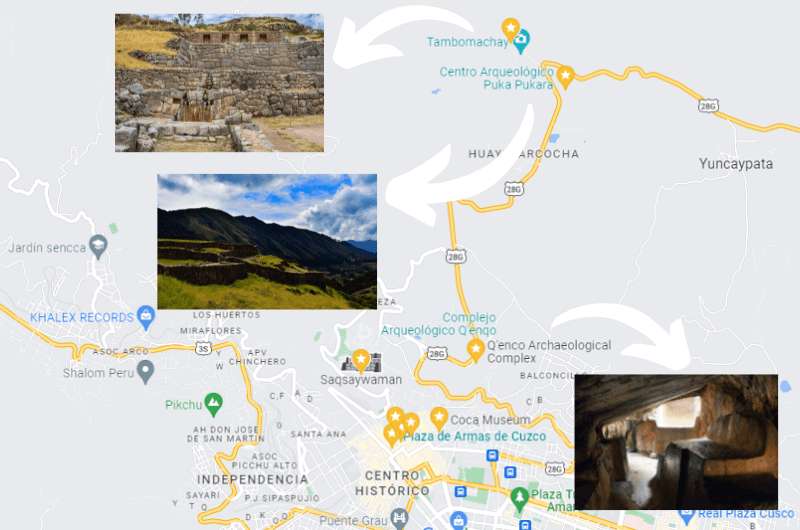
Tambomachay, Quenco and Puka Pukara are one of the most interesting Inca sites
Main sites visited on day 15: Sacsayhuaman, Tambomachay, Qenco and Puka Pukara
Hotel recommendation: Hilton Garden Inn
Today, you’ll be taking your first day trip out of Cusco—walking through history, exploring remnants of the Inca Empire, including Tambomachay, Qenco, and Puka Pukara. Take your car, because most of them are outside of town.
Morning: Explore Sacsayhuaman
The first place you’ll be visiting is Sacsayhuaman. It was an important fortified Inca complex, so it sits atop a steep hill, right above the San Cristobal viewpoint. It’s a massive site with not only Inca ruins but also great views of Sacred Valley and even Ausangate, the sacred mountain of the Incas.
You need an hour at the site.
Plan your day so that you can have lunch after you see Sacsayhuaman, since after this, you’ll be heading out into the boonies.
Afternoon: Visit the Inca sites right outside of town
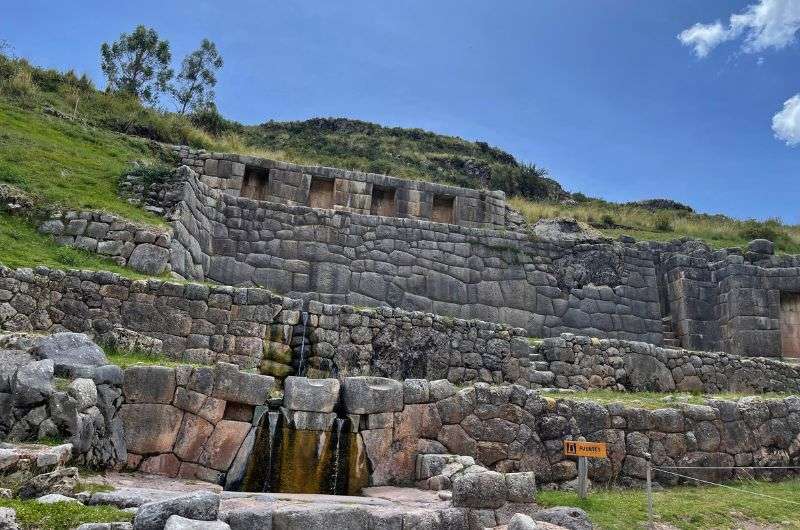
Tambomachay
Tambomachay, Qenco and Puka Pukara are next on your Inca itinerary for the day. They are all to the north of town. Qenco is right in the outskirts of Cusco while Tambomachay and Puka Pukara are a few kilometers outside of town, about 10 minutes by car.
A water worship center, a mummification area and an entry checkpoint into Cusco are what you’ll be seeing. You’ll probably be content with 30 minutes at each site.
Day 16: Day trip through Sacred Valley, the heart of the Inca Empire
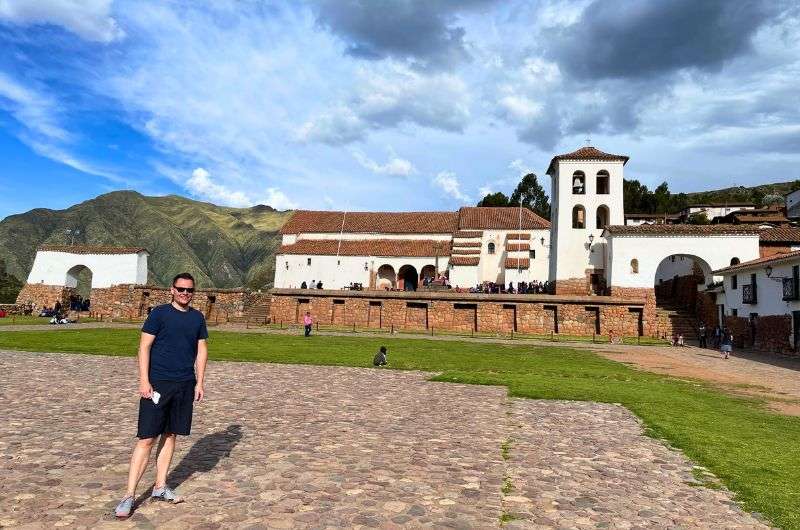
Me in a marvelous village of Chinchero while exploring Sacred Valley
Main sites visited on day 16: Pisac, Chinchero, Moray, Maras, Ollantaytambo
Restaurant tips: El Maqt’a
Hotel recommendation: Tambo del Inka, a Luxury Collection Resort, Luxury Sky Suites
No Peru trip would be complete without a proper trip to the Peruvian Andes. You’ll be taking a little road trip into the heart of the Inca Empire—Sacred Valley—passing iconic locations such as Pisac, Maras, and Ollantaytambo. It’ll be a whole lot of Inca ruins, but maybe even more exciting is the scenery. Peru’s Andes Mountains are awe-inspiring, and you’ll be awe-ing at every stop you make.
Learn more about each stop: Top 9 Things to do in Sacred Valley.
Morning: Drive to Pisac and Chinchero
First, drive 40 km (25 miles) to Pisac. It’s not far, but you’ll need an hour for the trip. This isn’t a highway! Once there, you might overlook the Inca ruins and just stare at the views of Sacred Valley. But the ruins of the fortress are vast, so they’ll require at least an hour or two of your attention.
Then you’ll head to Chinchero, a picturesque town where the locals still dress in traditional clothing. If you can come here on a Sunday you’ll experience a very nice market, not as touristy as most others. The drive between Pisac and Chinchero is 1.5 hours and about 75 km (45 miles).
Time for lunch! And I have a secret gem for you: Make sure to stop by the very local and very cute restaurant called El Maqt’a. It’s a gem I found on the road between Chinchero and Urubamba. See here for the location of El Maqt’a and don’t expect them to have a website, but do expect the pink corn beer, chicha.
Afternoon: Road trip to Moray, Maras, and Ollantaytambo
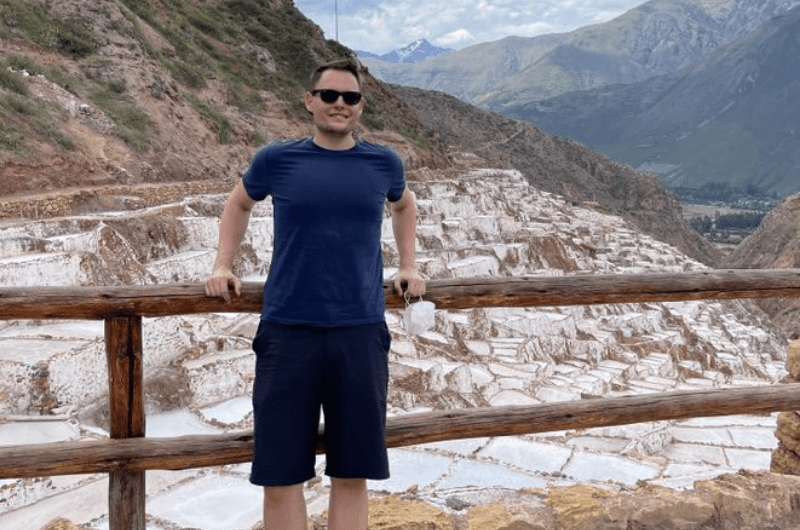
Lookin’ good at the Maras salt pools—important part of Sacred Valley
Continue 15 minutes from the restaurant to Moray, where the Incas experimented with growing different crops, and the circular sunken terraces are a very cool leftover of that agricultural laboratory.
You’ll be using your Cusco Tourist Ticket for Moray. You will spend up to an hour at the site.
Twenty minutes further and you’ll be stopping at Maras, which is a whole side of a mountain filled with thousands of salt evaporation pools. This is the spot where you’ll be buying a separate ticket at the entrance for PEN 10. Allow 30 minutes for your visit.
We have a dedicated Moray and Maras article for these two Inca sites.
Last but not least, drive 30 minutes to Ollantaytambo. This is the place where you’ll alight your train to Machu Picchu tomorrow, but first, check out some of the best-preserved Inca ruins in all of Peru. Don’t miss the chance to immerse yourself in the Sacred Valley’s rich history.
If you want to know all about the ruins and Ollantaytambo town, read my Ollantaytambo article. You’ll want to spend an hour or two at the ruins.
Hotel in Ollantaytambo or Urubamba
Since you’re heading out to Machu Picchu tomorrow morning, it makes no sense to go back to Cusco for the night today. Instead, stay at one of the hotels in Ollantaytambo. There are spectacular resorts there and especially around Urubamba, which is a city only 20 km (12 miles) away.
At Tambo del Inka, a Luxury Collection Resort , you get not only luxury everything, an exceptional spa and pool, but staff are also happy to share their Inca knowledge.
If you’re after something extra special, check this out: Vertical Sky Luxury Suites allow you to sleep in a glass pod hanging above the valley floor! You get your own Jacuzzi up there, too.
Day 17: Travel to Aguas Calientes and first day at Machu Picchu
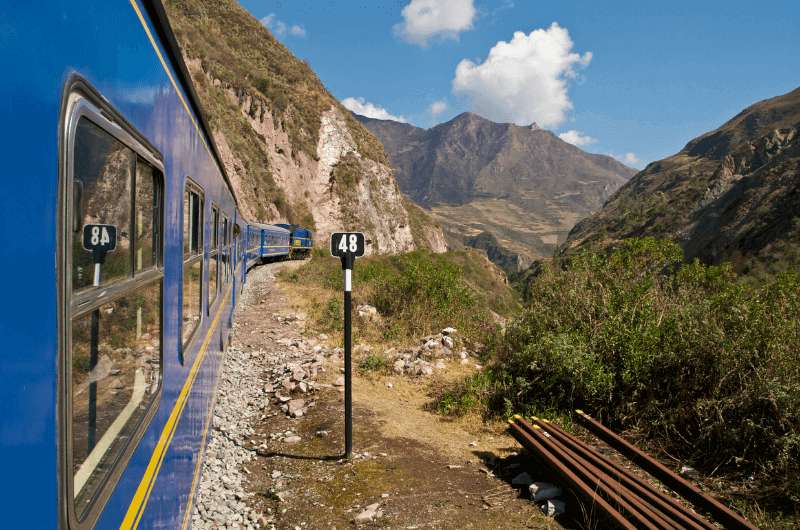
Train trip to Aguas Calientes with a wonderful view
Main sites visited on day 17: Train trip from Ollantaytambo to Aguas Calientes, Machu Picchu Inca ruins
Restaurant tips: Chullos in Aguas Calientes
Hotel recommendation: Sanctuary Lodge, A Belmond Hotel
Morning: Take a train from Ollantaytambo to Aguas Calientes
The first part of your day is going to be spent getting to Aguas Calientes, otherwise known as Machu Picchu Pueblo. You’ll want to go early morning, because you have a big day ahead of you—Machu Picchu!
The train trip from Ollantaytambo to Aguas Calientes takes 1.5 hours, costs USD 120 one way, and takes you through more stunning scenery, as you’ve probably gotten used to in Sacred Valley by now. There are two train companies to choose from: Peru Rail and Inca Rail.
You’ll want to buy your train tickets directly from the company websites right at the time you buy your Machu Picchu entrance ticket, which should be 3–6 months before your visit. For detailed instructions on how and when to buy tickets, see my article about How to get to Machu Picchu.
Once in Aguas Calientes, head over to the bus ticket office, Consettur, to get your tickets for the bus. Those cost USD 24 return.
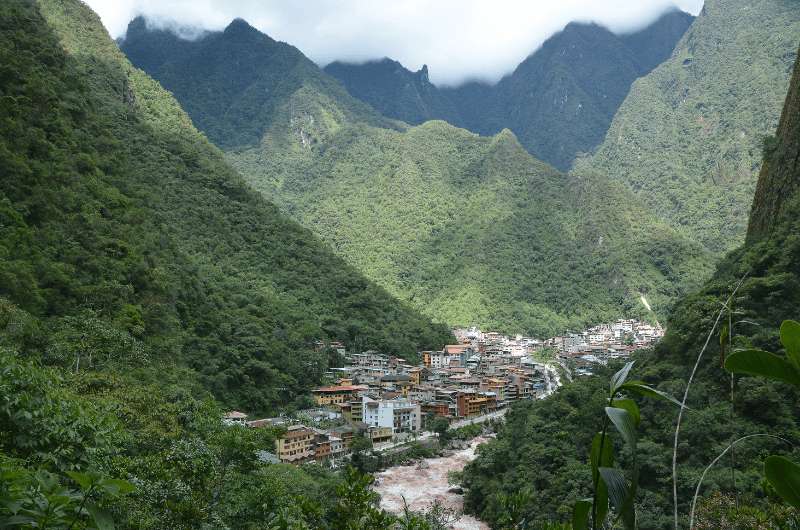
Aguas Calientes
Afternoon: Tour Machu Picchu
The bus tickets to Machu Picchu aren’t time stamped, so you’ll need to line up and hope to get on a bus at the time you want. Don’t worry though, because unless you want to be the first one there (in which case, have fun getting in line at 4 am!), there usually isn’t much of a wait. The bus trip up to the actual Inca city takes 20 minutes.
There are 10 routes to choose from at Machu Picchu, and you can’t just randomly wander around if you see something else that interests you. You have to stick to your chosen trail. Because of that, instead of a day trip, it makes sense to plan two visits to ensure you can fully visit Machu Picchu’s highlights.
I recommend buying two separate tickets: one with a mountain hike and one without. That way, you get the best of the best at Machu Picchu.
This afternoon, visit Machu Picchu on one of the Classic Circuits (circuit 2). Spend a few hours marveling at the ancient ruins, imagining life during the height of the Inca Empire.
My Machu Picchu travel guide explains everything from costs and tickets to getting there and if and how to get a guide. You can also find descriptions of all of the possible routes.

Day 18: Machu Picchu, part 2: Take a hike!
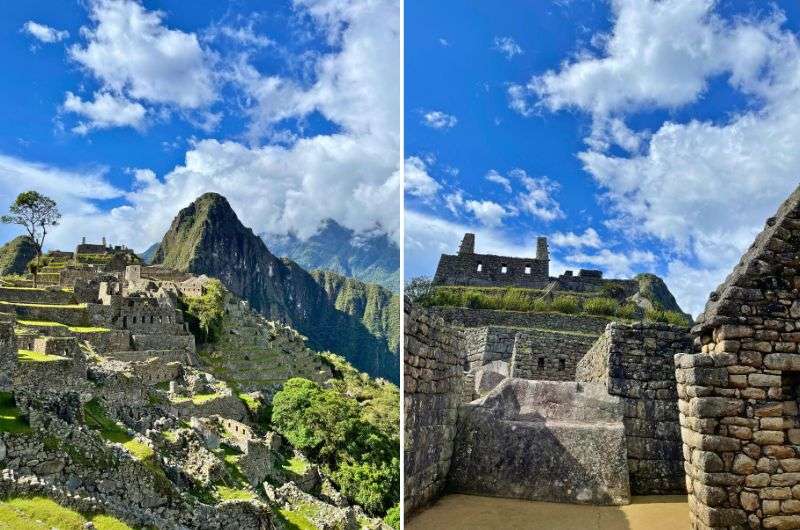
Further exploration of Machu Picchu
Main sites visited on day 17: Train trip from Ollantaytambo to Aguas Calientes, Machu Picchu Inca ruins
Restaurant tips: Chullos in Aguas Calientes
Hotel recommendation: Hilton Garden Inn Cusco
Don’t miss visiting Machu Picchu for a second day. It's worth every moment. I chose to hike Huayna Picchu, and it was fantastic. Not too strenuous or long but recommended as the most spectacular of all the hike options.
Morning: Climb up Huayna Picchu… if you dare!
No matter which hike you choose (you can also climb Machu Picchu Mountain), the hike tickets are only available for the mornings.
Getting up to Huayna Picchu is an adventure, with narrow pathways and super steep stairs that’ll make you climb them on all fours. Whatever you do, don’t look down! Until you get to the top, that is. It’s a great chance to explore the trails and visit Machu Picchu in-depth.
Afternoon: Chill out in Aguas Calientes
Once you get back down to Aguas Calientes, spend an hour of four at one of our favorite restaurants in Peru, Chullos. I could’ve (and literally almost did) spent the entire afternoon on their balcony overlooking the Urubamba River. If the views and divine food isn’t enough to persuade you, know that they serve their own beer and it’s fantastic!
You’ll need to head back to Cusco in the afternoon by spending 1.5 hours on the train back to Ollantaytambo and then driving 60 km (37 miles) to Cusco.
Day 19: Humantay Lake hike
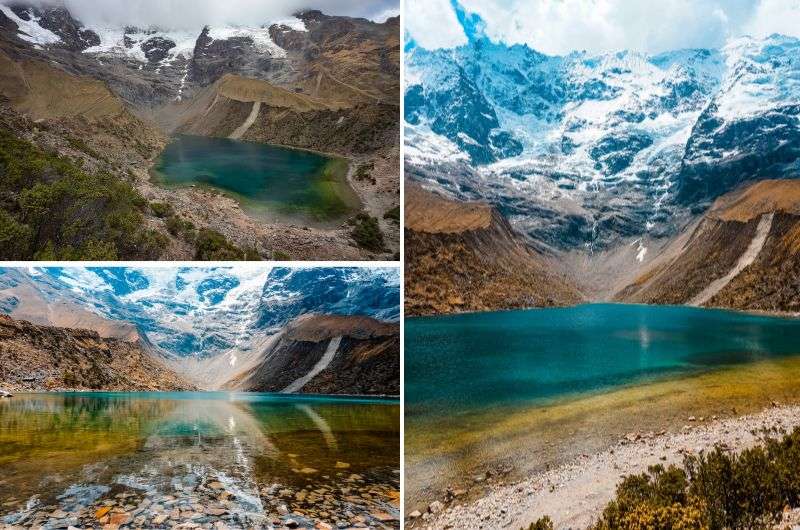
Humantay Lake
Main sites visited on day 19: Humantay Lake
Restaurant tips: Aulita in Cusco
Hotel recommendation: Hilton Garden Inn Cusco
I’ve got a fantastic green-blue lake in store for you today. It’s called Humantay and you’ll see organized tours to it everywhere in Cusco, but it’s in fact easy to reach on your own. It’s a gorgeous lagoon located under snow-capped Salcantay Mountain.
Morning: The drive from Cusco and a 2-hour hike
The drive from Cusco is 3 hours long to the trailhead at Soraypampa 120 km (75 miles) away.
The 2.6-mile loop hike will take you about 2 hours to complete, so it isn’t terribly long. The starting altitude is 3,800 m (12,460 ft) and the lake itself is at 4,200 m (13,780 ft), so the elevation gain is quite substantial over the short trek.
The trail to the lake is clearly visible, so no need for a guide. You can, however, rent a mule if the elevation gain is too much for you.
Keep in mind that tour groups from Cusco arrive at the trailhead around 7 am, so plan your arrival accordingly.
The entrance fee to Humantay Lake is PEN 10, payable in cash at the checkpoint in Mollepata.
Afternoon: Relax in Cusco
Head back to Cusco. Remember, the drive is 3 hours long, so you’ll be pretty pooped after you finally get back to the city.
One of our favorite restaurants in Peru, Aulita, could be just the place to relax and have a dinner and cocktail.
Day 20: Rainbow Mountain—a must-do Peru adventure!
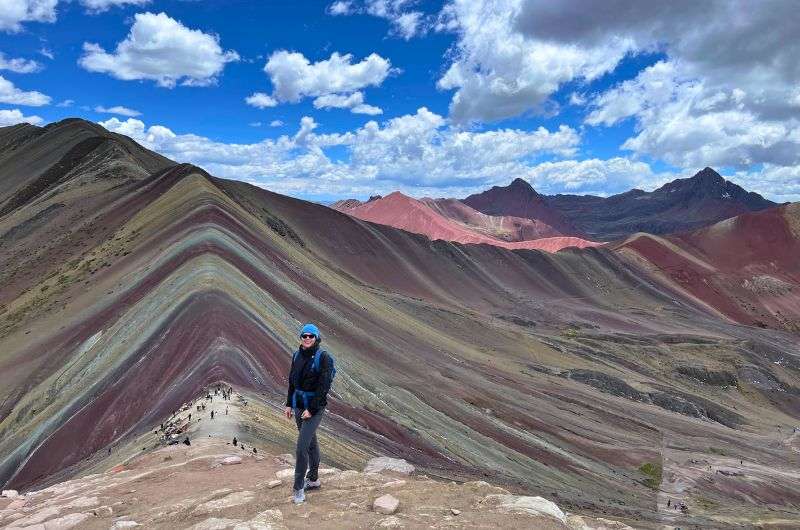
Not as colorful as on Instagram, but still beautiful
Main sites visited on day 20: Rainbow Mountain
Hotel recommendation: Hilton Garden Inn Cusco
Today, you’ll hike to the incredible Rainbow Mountain as part of this epic Peru itinerary. Get ready to drive (again!) for way too long and walk in way too thin air. Today you’ll get an answer to the burning question: Have I acclimatized enough?!
Located at an altitude of 5,200 m (17,000 ft), it’ll be a miracle if you aren’t reaching for coca tea after this day trip to Rainbow Mountain.
There are a few different routes you can take to see Rainbow Mountain aka Vinicunca (or the alternative named Palccoyo).
The standard route to Rainbow Mountain is called the Cusipata Trail. You start hiking at 4,600 m (15,000 ft) and continue for 3 km (1.8 miles) with a total elevation gain of about 400 m (1,300 ft), and then back the same way. So it’s not that long, but it’ll take you 2 hours to get up there and another 1.5 hours back down because you will be taking breathing breaks every 20 m (65 ft). The cost is PEN 40.
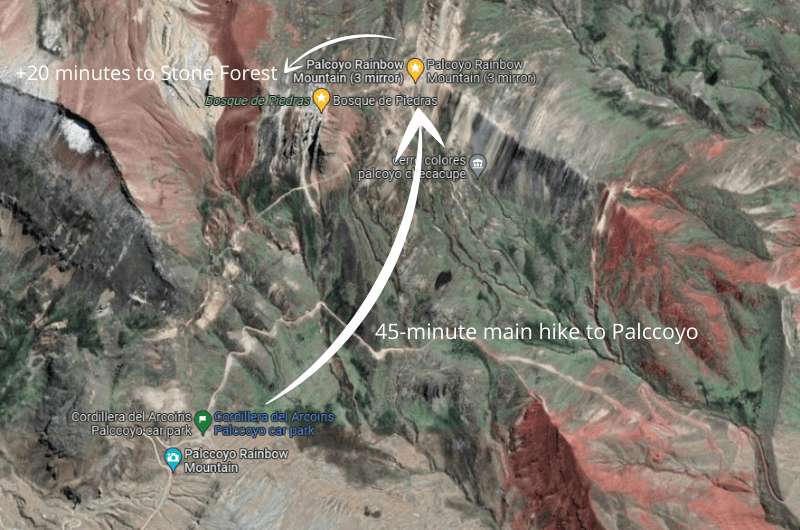
The trek to Palccoyo is easy enough with the lower altitude and almost flat terrain
The shorter Palccoyo Route is only 2 km (1.2 miles) long and takes you to a different rainbow mountain (several, actually) than the popular Rainbow Mountain. It's an easy hike of about 40 minutes. The cost is PEN 10.
No matter which starting point you decide on, you’re looking at a 3–4 hour drive from Cusco one way, so get up bright and early. It’s 100 km (62 miles), and at least half of that will be spent on mountain dirt roads.
Read my Rainbow Mountain travel guide to see which trail is right for you. There are also a couple of places worth a stop in the towns at the foot of the mountain—I talk about those in the article as well.
Day 21: Travel to Puno and Lake Titicaca
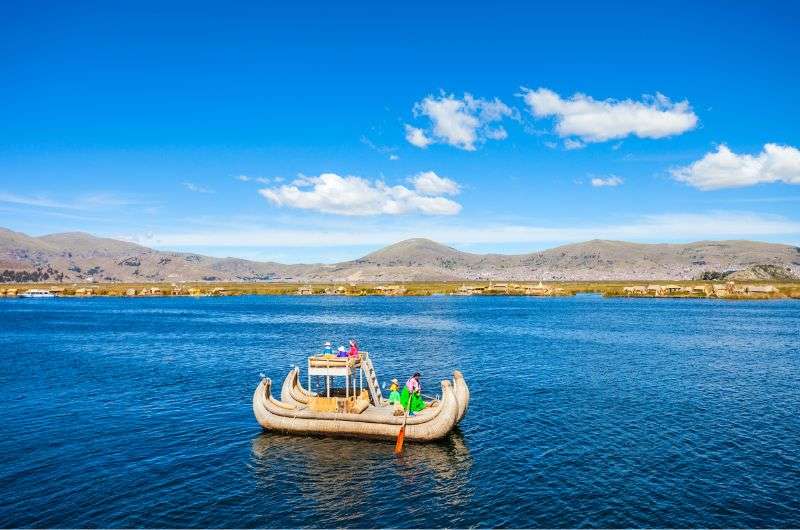
Lake Titicaca
Main sites visited on day 21: train to Lake Titicaca and possibly your hotel on a reed island
Hotel recommendation: QHAPAQ Lago Titicaca
The itinerary so far has been packed (btw, here’s my article on how to pack for travel), and you deserve a breather—and not just because you may have had trouble breathing yesterday at Rainbow Mountain. I’m not a huge fan of just sitting around, so get this: You’ll be traveling and resting at the same time today!
Why Lake Titicaca deserves a spot on your Peru itinerary
Lake Titicaca is the highest-altitude navigable lake in the world at 3,800 m (12,500 ft). It is located on the border of Peru and Bolivia, with the border line running right through the middle of the lake. The main gateway city on the Peruvian side is Puno.
The verdict: Lake Titicaca deserves a place on any longer Peru itinerary—it takes a long time to get there, and you don’t want your entire trip to be taken up by a train trip. Unless you have a month-long Peru itinerary, I’d give Lake Titicaca a miss.
Puno is 390 km (240 miles) from Cusco and the drive would take 6.5 hours. But get this: there is a luxury train line that chugs up and down this route. It is one of the most spectacular train routes…maybe even in the whole world.
Ride in Style: The Titicaca Train
PeruRail operates a 20s-inspired train simply called Titicaca. It takes 10 hours to get from Cusco to Puno on this train, and while that sounds long, it’s really not that hard to spend that time sipping pisco sours in the bar car, eating your 3-course lunch at a slow pace in the restaurant and ogling the fantastic scenery from the open-ended observation deck. There are some traditional music shows as well, but I prefer seeing the life that was unfolding outside the train.
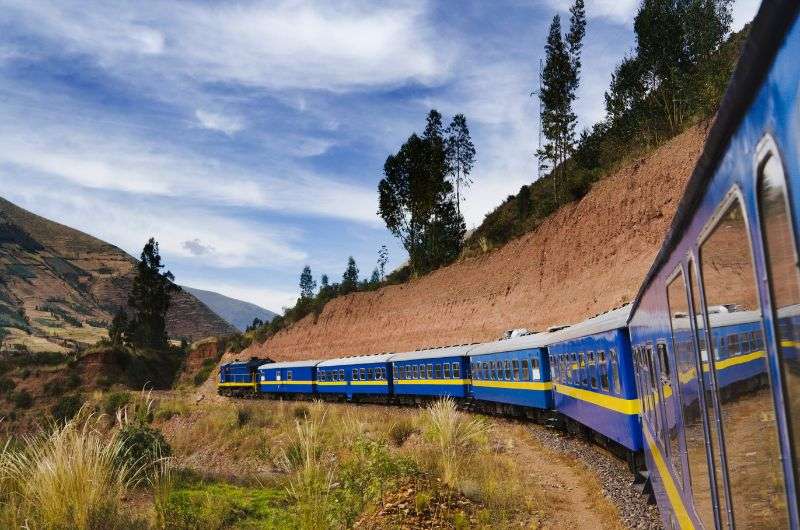
Scenic train ride to Titicaca
Beware the time schedule, because the PeruRail train does not depart every day. In low season there is just one departure a week, in high season there are currently three departures a week. The train leaves between 7–8 am depending on the day, from the Wanchaq train station in Cusco. You need to be at the station 30 minutes before departure time.
Buy your tickets online in advance for USD 275. They’ll include lunch, dinner, and a tea time snack. Don’t expect great food, but it’ll get the job done. An attendant stores your bulk luggage in a designated car. It’ll be released to you in Puno when you present your luggage ticket.
You’ll be passing through villages that don’t get visited by tourists and in that way get a small glimpse into real everyday life.
Alternative: The Belmond Andean Explorer, also by PeruRail, is an overnight train that is basically a 5-star hotel on rails. The USD 2400 price tag isn’t for everyone.
The train goes slowly and surely and no matter how rural the area outside your window looks, you’ll always see locals in traditional clothes either at work or taking a break from work, watching the train go by.
Take note that this is a high-altitude route, going as high as 4,350 m (14,200 ft). You’ll be stopping at the highest point, the Raya Pass, for just a few minutes while you let another train comes past. Good thing you’ve acclimatized in Arequipa and Cusco!
Puno’s train station is in the city center. You’ll arrive around 5–6 pm.
Hotel on Lake Titicaca: Stay with the Uros

Uros people
One of the standout points of interest at Lake Titicaca are the manmade islands of the Uros people—built of the reed that grows around Lake Titicaca. Seventeen reed islands, complete with reed houses and reed boats, are located on the lake.
Either that or stay in Puno town. Whichever you choose, book 2 nights.
Some of the families on the islands have made it possible for tourists to spend the night on their islands. Many are very basic rooms, but there is one standout: QHAPAQ Lago Titicaca.
The rooms are fantastic, with hot water, huge windows with infinite views of Lake Titicaca, and the friendliest family taking care of you. The food here is excellent, too, and comes included in the price of the room.
Day 22: Lake Titicaca, the highest lake in the world
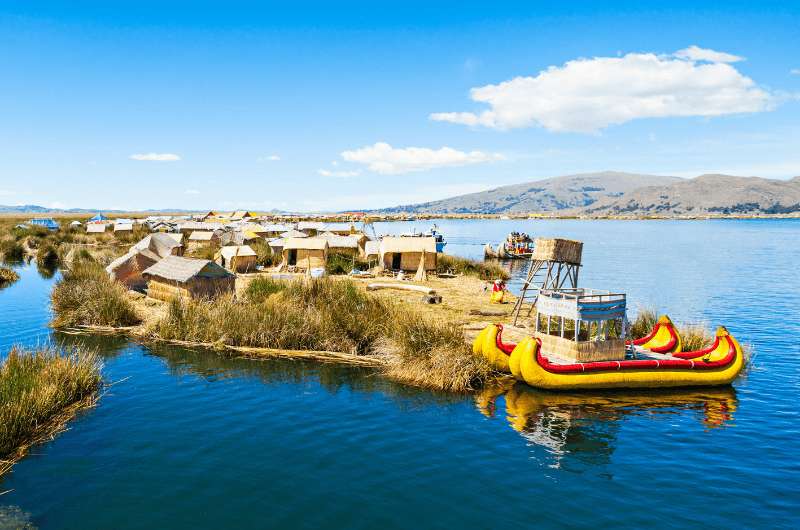
Boat tour on Lake Titicaca is a must
Main sites visited on day 22: Sillustrani burial ground, Lake Umayo
Hotel recommendation: QHAPAQ Lago Titicaca
Morning: Take a boat tour on Lake Titicaca
Take a boat tour around the islands of Lake Titicaca and learn about local life and show you why and how the people live on the water.
There are half-day trips available with prices starting at around USD 50 per person.
You’ll be back at your hotel for lunch.
Afternoon: Visit Sillustrani pre-Inca site
For the afternoon, choose a trip to Sillustani, a pre-Inca burial ground on the shore of another—much smaller—lake near Puno called Umayo. The tombs are in round towers called chullpas and they are scattered on the shore of the lake. Some destroyed, some not.
The views from the hills above the lake are also worth the scramble. See the island in the middle of the lake? It serves as a nature reserve for vicuñas.
The drive to Sillustani from Puno takes about 45 minutes and you’ll probably spend about an hour walking around the site. If you take a taxi, you’ll pay around USD 10. Organized tours will cost around USD 30.
Day 23: Lima: Travel back to Lima
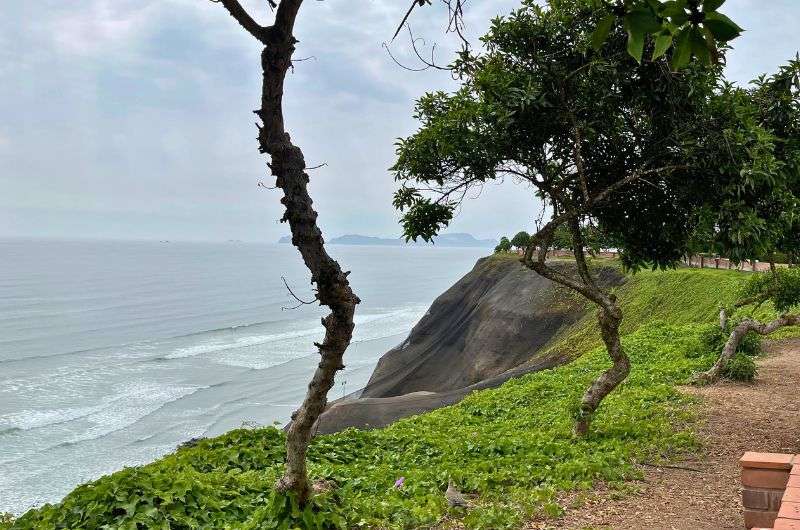
Limar, Miraflores
Main sites visited on day 23: Flight to Lima, Pachacamac ruins, Malecon boardwalk
Restaurant tips: Open Tapas Bar
Hotel recommendation: Radisson RED Miraflores
Morning: Hop on a flight from Puno to Lima
Have a grand breakfast and then get to the Puno airport for your flight to Lima. There are several departures throughout the day and tickets cost around USD 150. You’ll want to book a morning flight if you want to have enough time for the activity in Lima in the afternoon.
Afternoon: Spend some time at Pachacamac ruins
Take a taxi to the ruins of a city called Pachacamac about 40 km (25 miles) south of central Lima. Pacha Kamaq (which means Earth Maker) was the creator god of the Peruvians before the Inca times. There are many myths surrounding this god, and I urge you to read up on him prior to visiting “his” city.
There is a modern museum at the site that’s a good introduction to the historical background of the area. It’ll take you maximum one hour to get through. Then, take 1.5 hours to walk around the ruins. I recommend a guide, but it is possible to go on your own.
Tickets cost PEN 15, guided tour is PEN 30.
Evening in Miraflores
Later, you watch the sunset at the Miraflores boardwalk, called the Malecón, that takes you to the cliffs over the ocean. After sunset, head inland to one of the top bars in Miraflores called Open Tapas Bar.
Day 24: Iquitos, the capital of the Peruvian Amazon
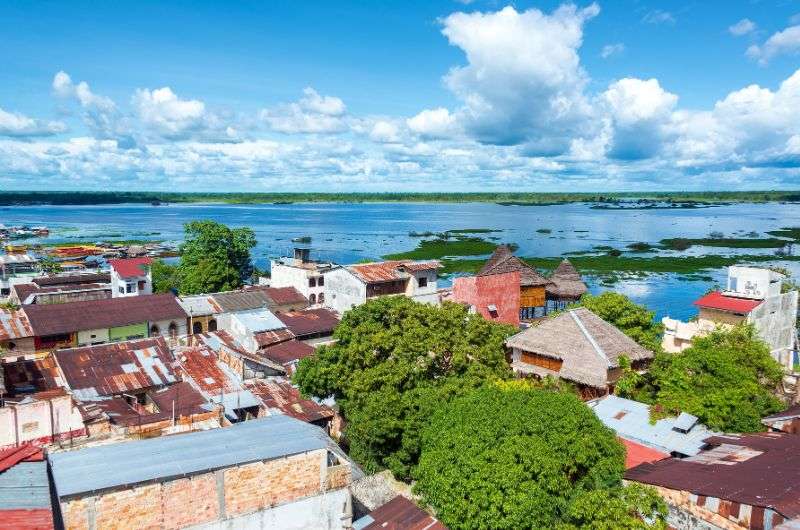
Iquitos, the gateway to Amazon Forest
Main sites visited on day 24: Flight from Lima to Iquitos, Iquitos city center, the Pilpintuwasi Animal Rescue Center
Hotel recommendation: DoubleTree by Hilton Iquitos
Iquitos is the “Capital of the Peruvian Amazon”. The not-exactly-charming city has a population of roughly half a million people, so it’s no village. There is no road leading into it, so you will need to get on yet another flight. But the Amazon Jungle awaits, so it’s worth the effort!
You’ll use Iquitos as a gateway to the Amazon Rainforest and exploring the Pacaya Samiria National Reserve.
Morning: Arrive in Iquitos
Flights from Lima take almost 2 hours and cost USD 100. A taxi from the airport to town will be around USD 5.
You can take in the noise or the engines and horns of the motorbikes at the Plaza de Armas (remember, there are almost no cars in Iquitos). The city is busy, a little dirty, and you can see poverty. So not exactly unicorns and rainbows, but you’re here so you might as well try to enjoy it while you’re here.
Iquitos center is full of colonial mansions, so take a stroll there and then check out the Tarapaca Malecon, a fairly manicured promenade on the riverbank not far from the main city square. You’ll find cafes and restaurants there, as well as views of the river and the houses that are built on and around it. A start contrast to those villas in the center!
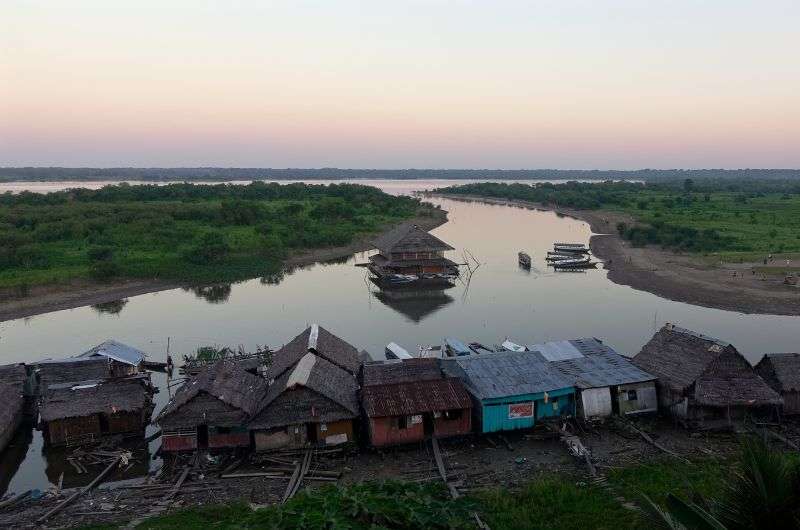
It's not the prettiest city, but it's right next to the Amazon rainforest.
Afternoon: Learn about animal trafficking
Hop on a 20-minute boat ride (PEN 5) on the Nanay river to visit the Pilpintuwasi Animal Rescue Center. It’s located in the Padre Cocha community.
Boats leave from the Bellavista Nanay port on the very north of Iquitos. Once in Padre Cocha it is a 15 minute walk to the center. Ask around for directions.
DO NOT go to the other center right by Pilpintuwasi, they pretend to rescue animals but don‘t. They just saw that tourists were coming to Pilpintuwasi and wanted some tourist dollars too.
There are guided tours at Pilpintuwasi daily except Mondays where you can see some of the luckier animals that got taken from the jungle. You’ll meet jaguars, ocelots, a tapir, parrots, a toucan, and many different species of monkeys. And there’s a butterfly village. The price is PEN 30.
Through education, rescue and rehabilitation, they are trying to end animal trafficking in the region. A lot of it happens at the notorious Belen market in Iquitos, so we’d skip that place.
Day 25: Pacaya Samiria National Reserve
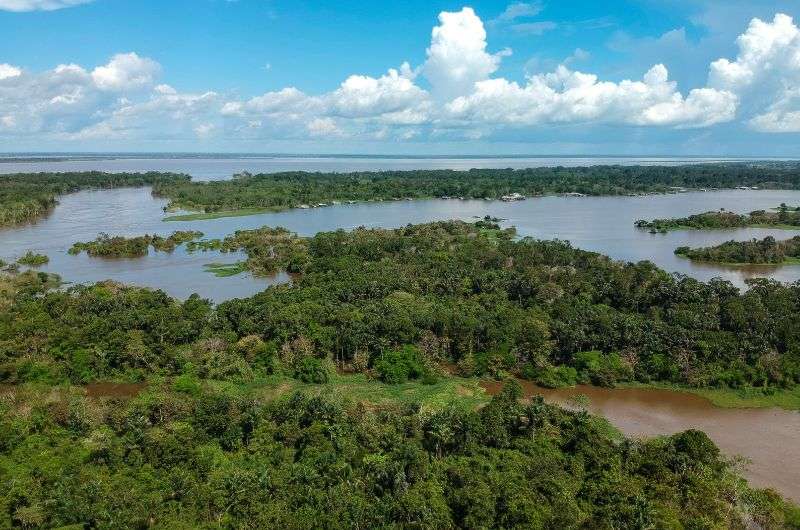
Pacaya Samiria National Reserve
Main sites visited on day 25: Travel to your jungle lodge, one of the activities on offer in the jungle
Hotel recommendation: Pacaya Samiria Amazon Lodge
Pacaya Samiria National Reserve is the triangular bit between the Marañón River and the Ucayali River, both of which become the Amazon River at their confluence.
About 40,000 people and a large variety of animals call the reserve home. Pink river dolphins, piranhas, sloths, caiman, manatees, pumas, jaguars and all sorts of primates are some of them.
There are many lodges in the jungle surrounding the reserve (none in the actual reserve obviously) that offer a multitude of different experiences, trips and themed stays.
The lodge we’re recommending, the Pacaya Samiria Amazon Lodge, is the one that is the closest to the reserve, about 120 km (75 miles) southwest of Iquitos.
Morning: Travel into the jungle
To get to the Pacaya Samiria Amazon Lodge, you’ll need to travel 2.5 hours on land and water. Transfers are organized by the lodge.
Even if you stay anywhere else, you’ll always have the transportation provided by your accommodation provider because getting into the jungle isn’t something you just go and do on your own.
Afternoon: Introduction to the jungle
Take part in some of the programs offered based on what you enjoy. This can be anything from a walk through the lodge’s private reserve to learning how to climb palm trees like the Amazonian people.
Day 26–28: Amazon Jungle activities
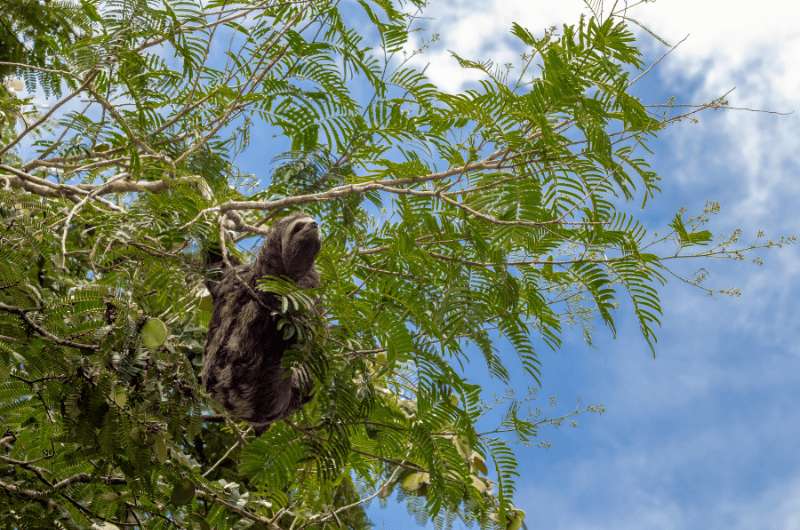
You might even meet a sloth in the Amazon rainforest! Who wouldn't want to meet one at least once in their life?
Main sites visited on day 26–28: Amazon activities for 3 full days
Hotel recommendation: Pacaya Samiria Amazon Lodge
Spend three full days exploring the jungle.
You can focus on the nature on one day. Besides actual jungle hikes, you could be doing things like visiting the confluence of the Ucayali and Marañon Rivers and searching for amphibians and reptiles, or trying to spot pink river dolphins. If you’ve visiting in October or November, you might be able to take part in releasing baby turtles into the river.
The next day could be spent with local communities, getting to know their culture and learning about how they make handicrafts. You could even try your hand at cooking traditional dishes.
Your last day could be a wellness program like a detox or yoga experience with workshops on traditional medicine.
Day 29: Back to Lima before departure
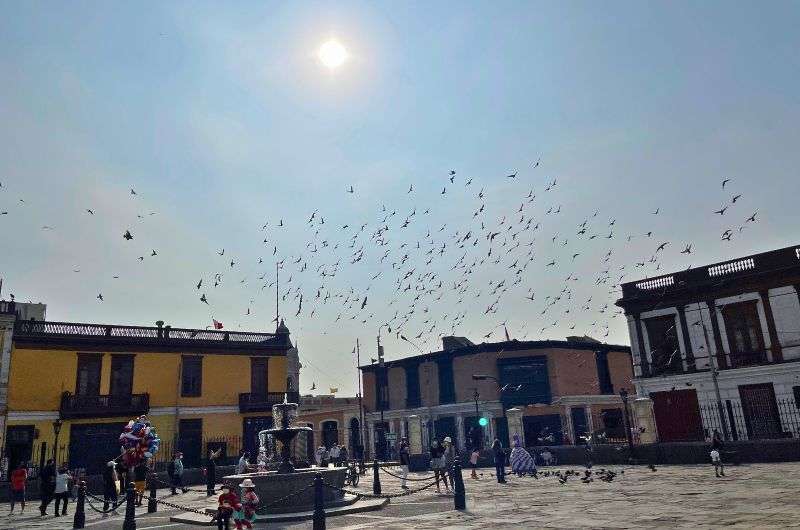
I will end my Peru itinerary back in my not so favorite Lima. Yaay!
Main sites visited on day 29: Flight from Iquitos to Lima,
Restaurant tips: Iron House Restaurant in Iquitos,
Hotel recommendation: Miraflores Hilton Hotel or the Radisson Red Miraflores
Time to head back to civilization, you’re 1 month in Peru itinerary is coming to an end. Are you exhausted yet?
Morning: Journey back to Iquitos
Depending on which lodge you chose to stay at, getting back to Iquitos will take you up to 2.5 hours. So that’s your morning pretty much gone.
Once in the city, you can grab a lunch at the Iron House Restaurant, which sits right on the Plaza de Armas. The Iron House that the restaurant is part of is a famous building, being called the finest example of civil architecture in Peru.
You can sit on the balcony and people-watch with the deafening scooter noise in the background. The perfect way to end your stay in the tranquil jungle, no? Just do yourself a favor and choose one of the more Peruvian-inspired dishes. The burgers and other western-style meals could leave you disappointed.
Afternoon: Fly to Lima
Flight to Lima. Remember they take almost 2 hours and cost about USD 100. There are many departures throughout the day.
Nothing further planned for the day. Get yourself in a nice hotel and just enjoy your last hours in the country with some good food and pampering.
Day 30: Departure from Peru
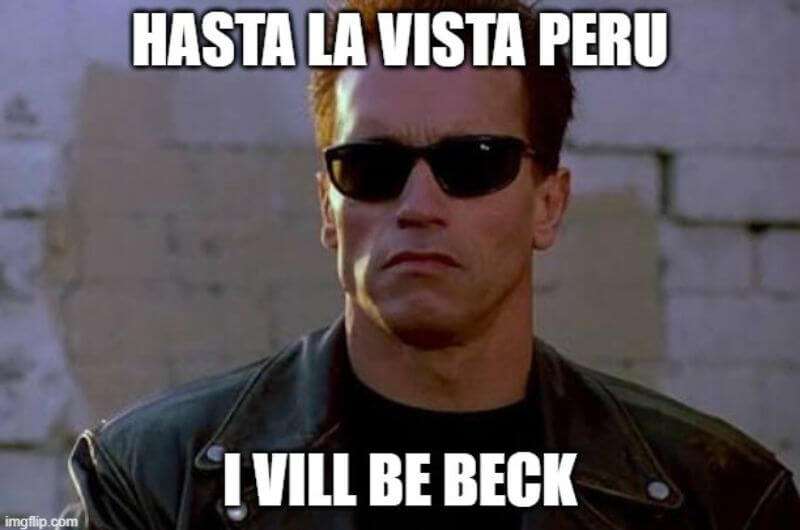
There’s nothing left to say, you’ll need to come back to Peru another day! Believe it or not, there’s still plenty to see and do in Peru, and you'll be sad you don't have a few more days to visit Peru. But now it’s time to return to Lima airport for your flight home after this unforgettable adventure.
(And if you were just dreaming about a vacation that long and you have to come back down to reality now, hop over to my 2-week Peru itinerary.)
For example, I didn’t take you to Huaraz, the hiking capital of Peru, on this itinerary, because getting there is just so damn annoying! No flights, wtf?!
Or, if you—unlike me—don’t mind overnight treks, there are tons of them not just out of Huaraz, but Cusco as well. I’d love to visit the true lost city of the Incas, Vilcabamba. Or trek the sacred Ausangate… or…
I’ll be back for sure. Will you? Visit Peru again and explore even more of its wonders!
Sometimes, all you need to do is take the first step... I've filtered out the best hotels in Peru for you
Save it for yourself to come back to later, or share with your friends on social media!
You might also be interested in reading:
- The Best 3-Day Cusco Itinerary with Sacred Valley Day Trip
- A 2-Week Peru Itinerary: A Day-By-Day Trip Plan
- Top 14 Handpicked Luxury Hotels in Peru
- The 10 Best Ruins to Visit in Peru
- Top 9 Places to See in Sacred Valley
This post contains affiliate links. I earn a small commission if you make bookings through my links, at no additional cost to you. Thank you for your support!
How to spend 1 month in Peru? Entire trip overview:
Peru itinerary map: What to see in Peru in 1 month
My top tips for one month in Peru:
Day 1: Arrival in Lima + getting to your hotel
Day 2: Lima: Historic center and Miraflores
Day 3: Chan Chan, UNESCO World Heritage Site
Day 5: Paracas and Paracas National Reserve, the coastal gems of Peru
Day 6: Islas Ballestas boat tour and water sports in Paracas
Day 7: Sandboarding in Huacachina and pisco tasting Ica
Day 8: Nazca Lines day trip (and lots of driving)
Day 9: Drive to Lima, then fly to Arequipa
Day 10: Arequipa, Peru’s “White City”
Day 11: Laguna de Salinas and whitewater rafting
Day 12: Hit the main viewpoints of Colca Canyon + see condors
Day 15: Inca sites in and around Cusco
Day 16: Day trip through Sacred Valley, the heart of the Inca Empire
Day 17: Travel to Aguas Calientes and first day at Machu Picchu
Day 18: Machu Picchu, part 2: Take a hike!
Day 20: Rainbow Mountain—a must-do Peru adventure!
Day 21: Travel to Puno and Lake Titicaca
Day 22: Lake Titicaca, the highest lake in the world
Day 23: Lima: Travel back to Lima
Day 24: Iquitos, the capital of the Peruvian Amazon
Day 25: Pacaya Samiria National Reserve




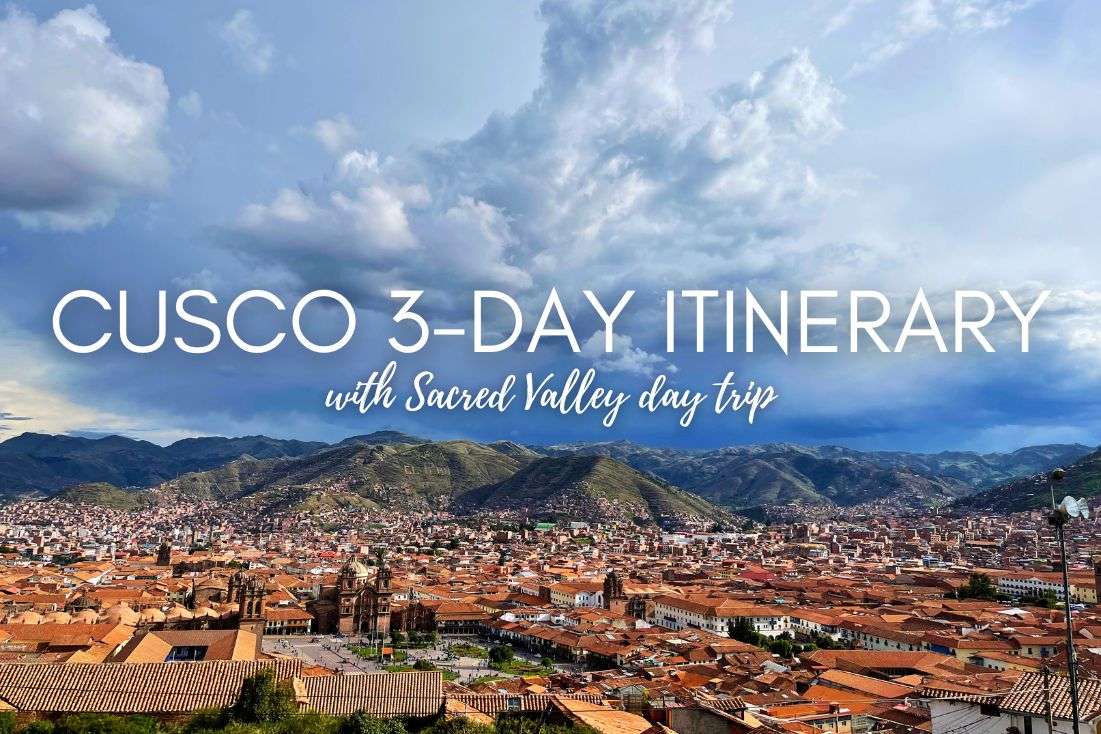
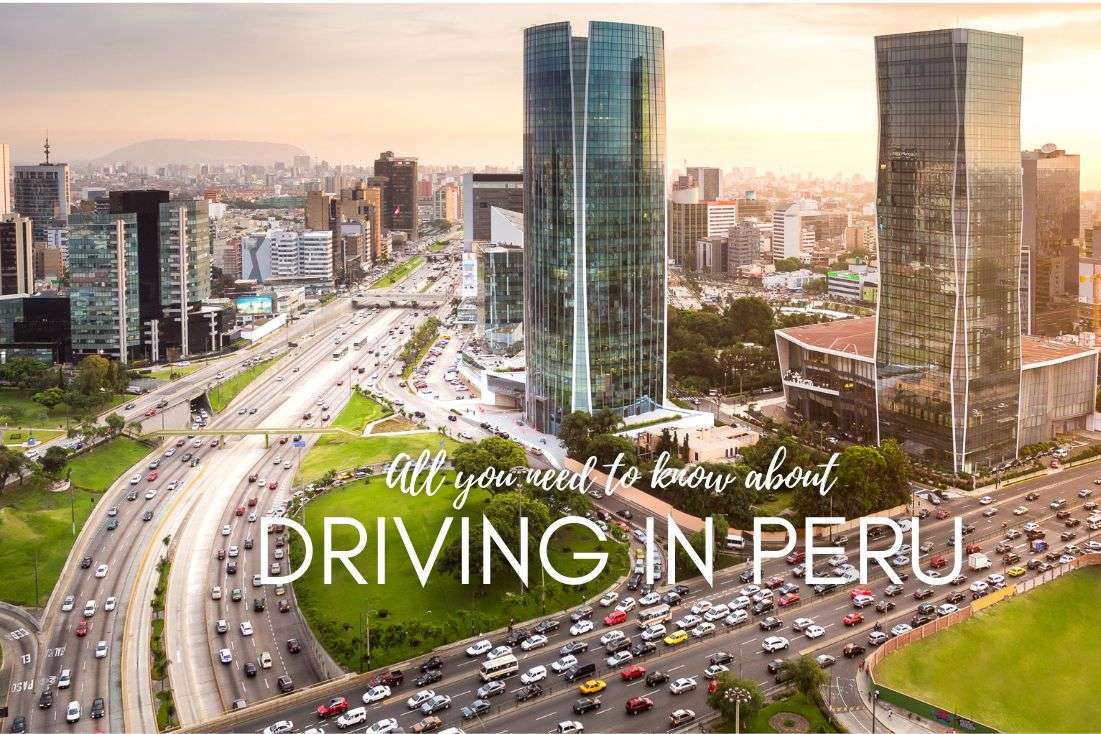




Comments | Thoughts? Give us a shout!